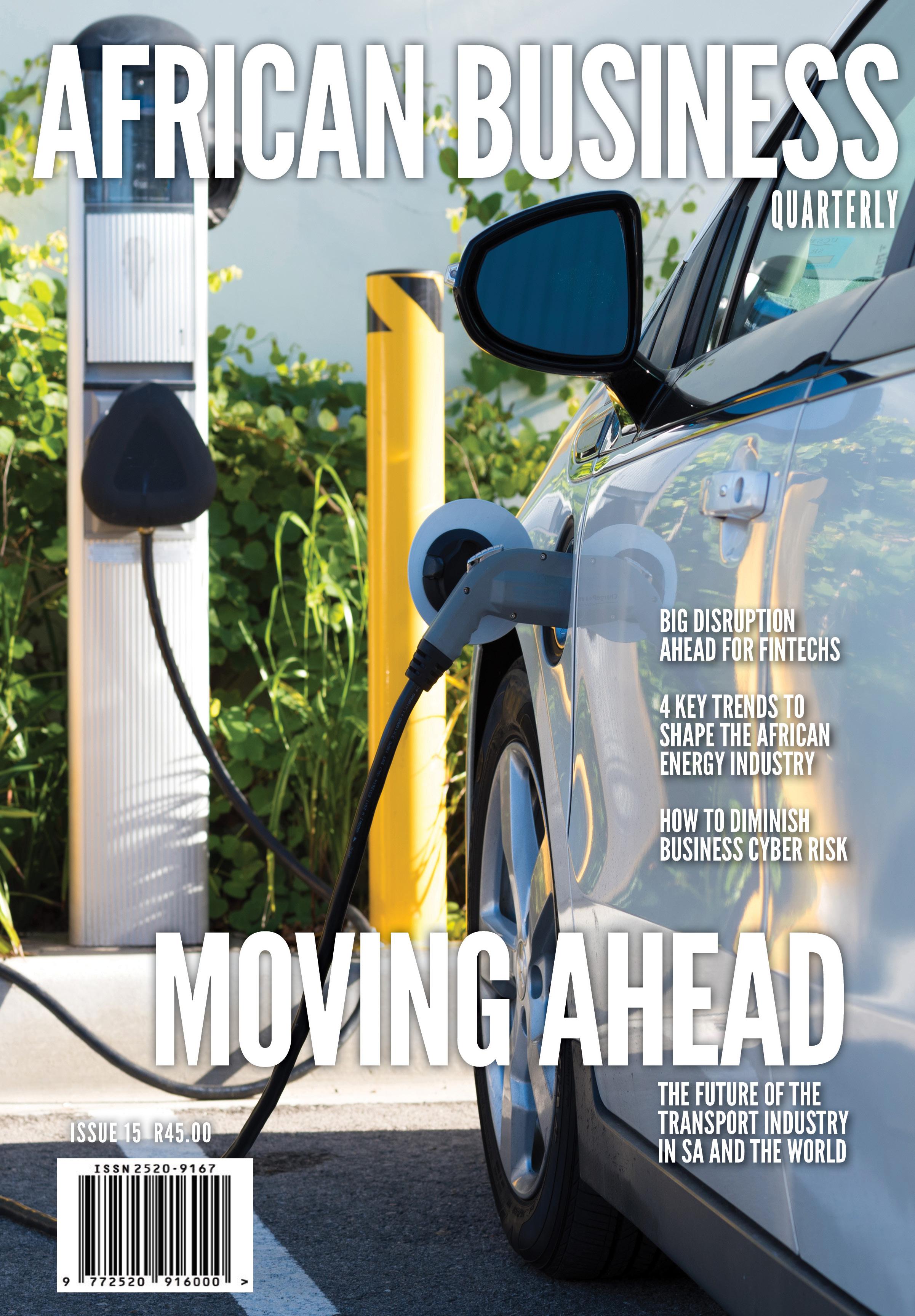
And still have time for your family
Your business has something special to offer and our job is to give your customers a way to discover you and your brand online.


2 AFRICAN BUSINESS QUARTERLY
We help you develop your story and your voice and connect with the clients who want to do business with you. We like to talk about your business as much as you enjoy sharing it with others. That means we treat your business like it’s our own. We get down to the nitty gritty and find out as much as we can in an initial free consultation with you where you let us in on the journey you’ve taken up to this point and the goals you have, moving forward. We’ll be actively by your side all the way because your success is our success.
Let’s chat about your business!
Chat with us on WhatsApp Visit our website

Aim higher and connect more with Telkom Naledi packages. Elevate your team to new heights with exclusive Telkom Naledi packages that offer great office connectivity solutions and value.
an appointment for the full presentation. Email us at RT15enquiries@telkom.co.za
Book
Aim higher and connect more with Telkom Naledi packages.
RT15
Exclusive Offers Advantages
Telkom Naledi Gold
• Uncapped data
• 20GB streaming data
• Unlimited Closed-User Group Minutes (Telkom-to-Telkom calls including Telkom landline)
• 200 Other-Network Minutes
• Unlimited SMSs
• SIM-only R350
• Mobile service with mobile device
Telkom Naledi Platinum
• Uncapped data
• 20GB streaming data
• Unlimited Closed-User Group Minutes (Telkom-to-Telkom calls including Telkom landline)
• 600 Other-Network Minutes
• Unlimited SMSs
• SIM-only R500
• Mobile service with mobile device
Book an appointment for the full presentation. Email us at RT15enquiries@telkom.co.za
Uncapped data with no FUP applied to the package. Data access will never be terminated or stopped. Includes WhatsApp.
Telkom Naledi packages come with a dedicated streaming bundle for YouTube, Facebook, Facebook Messenger, Twitter, Instagram, LinkedIn and WhatsApp.
Network-based CUG. Telkom is the only company that offers this converged voice-call solution across fixed and mobile numbers, which will result in significant voice-calling savings.
State users on Top-Up options can top up their all-net minutes at the discounted State OOB rate of R0.45 (36% discount).
Full allocation of all package bundles and benefits even if a SIM is activated mid-month. No proration is applied – as we would do normally.
Event billing and premium-rated events can be blocked at a SIM level, backed by the setting of a zero spend limit.
CONTENTS

08 FROM THE EDITOR
10 MEET UP
Rub shoulders and conduct business with the high-flyers in African business

12 DIGITAL
How to diminish cyber-related business risks with detection and response



20 BANKING
How international banking from Mauritius is transforming the economic landscape in sub-Saharan Africa?
28 FINANCE
Tough economic headwinds provide exciting opportunities for agile, customer-centric fintechs
32 ENERGY
Four top trends to watch in the African energy sector in 2024

36 ENTREPRENEURSHIP
Working capital in two hours—a game-changer for South Africa’s SMEs

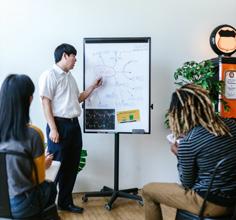
42 OCEAN ECONOMY
Uncovering investment and job-creation potential in the KwaZulu-Natal South Coast’s ocean economy
48 SKILLS
Shaping the skills and jobs of youth in Mozambique with technical and vocational training
ISSUE 15
6 AFRICAN BUSINESS QUARTERLY ISSUE 15








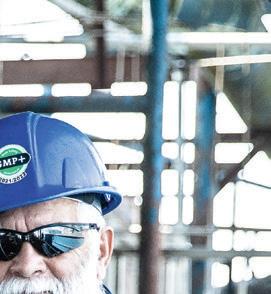
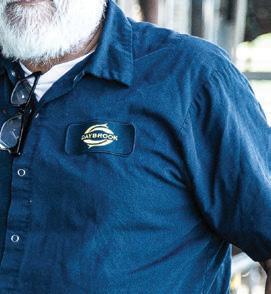


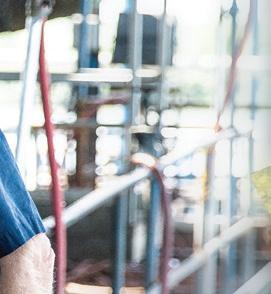


CONTENTS
ISSUE
15



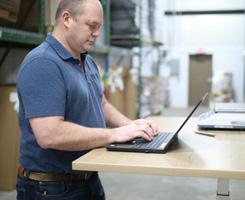



SPECIAL FOCUS: TRANSPORT
52 DIGITAL TRANSFORMATION
How new digital technology is revolutionising global relocations, redefining the way people move
58 MANUFACTURING
IDTechEx report finds that removing rare-earths drives demand for copper in electric vehicle motors
62 SUPPLY CHAINS
Optimisation through ERP intelligence: allowing richer visibility and monitoring of performance, raw material availability, shipping and more
68 SUSTAINABILITY
How climate-neutral mobility can ensure sustainable economic growth on the African continent
72 INFRASTRUCTURE
Private-public partnerships are the most viable solution to improving transport infrastructure in South Africa
76 AIR
Shifting megatrends see the rapid evolution of electric air taxis and emergence of generative AI as driving forces in travel and transport 8 AFRICAN BUSINESS QUARTERLY ISSUE 15
WHAT YOU NEED TO KNOW ABOUT OVUM CORPORATION

Global Projects

From
Currently, Ovum Corporation is involved in a range of exciting projects that highlight our dedication to excellence and innovation Our projects have taken us around the world

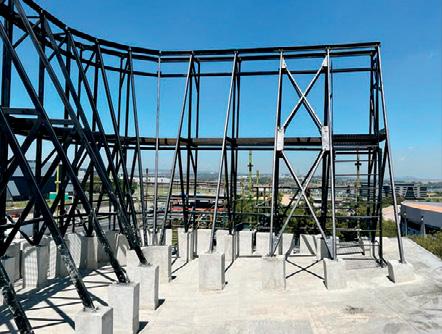
Our diverse portfolio includes various sectors From commercial buildings, hotels, and shopping centers to industrial plants, mining operations, and telecommunication towers, Ovum Corporation has a proven track record of successfully delivering complex projects Our comprehensive capabilities extend to cable stay structures, balanced cantilever bridges, and more

Sustainability

Ovum Corporation is on a journey to become a world-class Africanbased design consulting company, offering sustainable solutions that transform infrastructure planning, design, and delivery
By embracing the latest technologies and forward-thinking approaches, we create the perfect space and environment for our clients to realize their project ideas with confidence

WELCOME TO OVUM CORPORATION
Ovum Corporation, a leading civil engineering consultancy based in South Africa, is making waves in the industry with its exceptional expertise and commitment to sustainable infrastructure solutions Established in June 2020, Ovum Corporation has swiftly gained a reputation for delivering cutting-edge structural and hydraulic designs for a wide range of modern infrastructure projects across the globe.
Our mission is clear: to provide aesthetically enhancing, sustainable infrastructure planning, design, and delivery solutions throughout Africa and beyond. By combining international best practices with our deep understanding of local conditions, we offer our clients unmatched insight and expertise With a strong emphasis on collaboration and teamwork, we partner with leading architects and corporate clients to develop innovative solutions that not only preserve ecosystems but also help communities thrive
At Ovum Corporation, we understand the importance of optimizing project delivery to ensure timely completion and cost-effectiveness
To achieve this, we employ the latest Building Information Modelling (BIM) software, cutting-edge analysis techniques, and state-of-the-art project visualization programs. By leveraging these advanced tools, we bring our clients' visions to life, allowing them to explore their project ideas in the most engaging and interactive manner.
For more information about Ovum Corporation and our groundbreaking projects, please visit our website at www ovumcorporation com Let us be your trusted partner in turning your infrastructure dreams into a vibrant and sustainable reality
w w w . o v u m c o r p o r a t i o n . c o m n i c h o l a s f @ o v u m c o r p o r a t i o n . c o m
in Bangladesh to the Worcester to Glen Heatlie project in the Western Cape, our team is leaving an indelible mark across the globe
the Dhaka Elevated Expressway
Expertise
O V U M C O R P O R A T I O N O V U M C O R P O R A T I O N
Welcome to African Business Quarterly 15, our first edition of what I trust will be a successful year for us all.
South Africa grapples with various challenges that impact its business landscape. Persistent issues such as high unemployment rates, economic inequality and a history of political uncertainties have posed hurdles to sustained growth. Additionally, the country faces energy constraints, affecting industries and hindering the potential for foreign investment.
The COVID-19 pandemic further exacerbated these challenges, impacting businesses across sectors. Lockdowns, supply chain disruptions and shifts in consumer behaviour have necessitated adaptation and resilience in the face of unpr ecedented challenges.
Despite the challenges, South Africa presents numerous opportunities for businesses to thrive. The nation's commitment to economic reforms, infrastructure development and the adoption of digital technologies positions it for futur e growth. The government's focus on attracting foreign direct investment, coupled with initiatives to support SMEs, creates an environment conducive to business development.
With a rapidly growing population and emerging middle-class in many African countries, South Africa can serve as a hub for businesses looking to expand their footprint across the continent.
Renewable energy initiatives have gained momentum, offering potential solutions to the country's power challenges. Investments in solar and win d energy projects not only address energy constraints but also contribute to a mo re sustainable and environmentally friendly business environment.
The government has demonstrated a commitment to economic reforms aimed at stimulating growth and attracting investment. Streamlining bure aucratic processes, addressing corruption and implementing policies that support job creation are pivotal steps in creating a conducive business environment.
South Africa's business outlook reflects a nation at a crossroads, balancing challenges with opportunities. While the road ahead may be challenging, th e country's commitment to reform, coupled with a resilient entrepreneurial spirit, signals a potential for growth and prosperity.
Businesses that navigate the complexities, leverage opportunities and contribute to sustainable development are likely to play a crucial role in shaping the country's economic future.
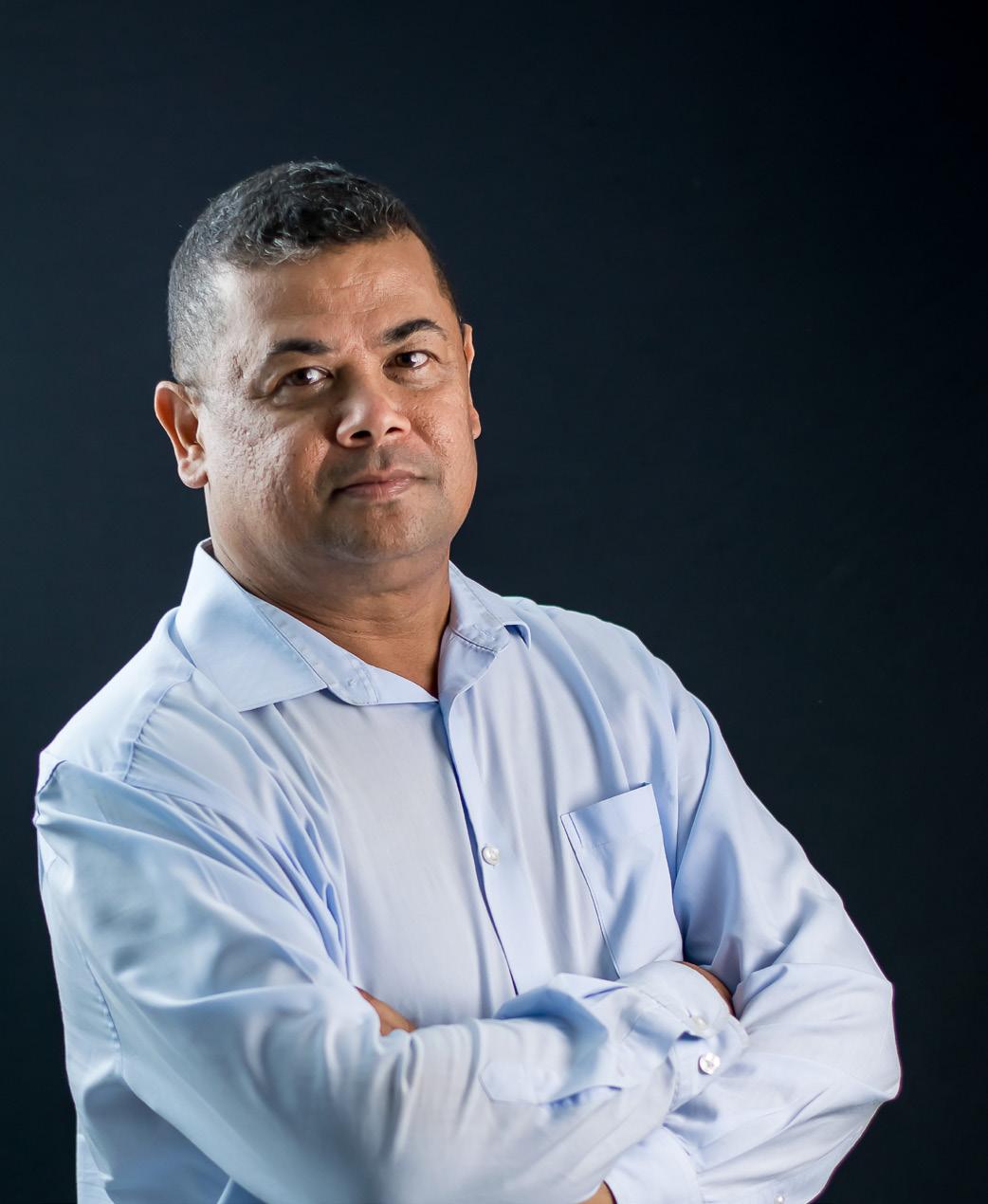
Donovan Abrahams
Ashley van Schalkwyk ashley@avengmedia.co.za
Tania Griffin tania@avengmedia.co.za
Shadon Carsten
TheConversation.com
The World Bank Group
Andy Jury
Ian Pettey
Roelof van den Berg
Dr James Edmondson
Adobe Stock, Freepik, Unsplash, Pexels, Pixabay, SA Tourism
Viwe Ncapai
SALES ACCOUNTS
CLIENT LIAISON
ONLINE CO-ORDINATORS
IT & SOCIAL MEDIA
HR MANAGER
PRINTER DISTRIBUTION
DIRECTORS
PUBLISHED BY
Lunga Ziwele, Reginald Motsoahae, Charlton Peters, Andre Evans, Kim Jeneke, Mellouise Thomas, Wendy Scullard
Benita Abrahams
Bianca Alfos
Majdah Rogers
Majdah Rogers
Ashley van Schalkwyk
Tharwuah Slemang
Colin Samuels
Novus Print
www.abizq.co.za, www.issuu.com
Donovan Abrahams
Colin Samuels
Aveng Media


10 AFRICAN BUSINESS QUARTERLY ISSUE 15
ADDRESS: Boland Bank Building, 5th Floor, 18 Lower Burg Street, Cape Town, 8000 Tel: 021 418 3090 | Fax: 021 418 3064 Email: majdah@avengmedia.co.za Website: www.mother&child.co.za DISCLAIMER: © 2024 African Business Quarterly magazine is published by Aveng Media (Pty) Ltd. The Publisher and Editor are not responsible for any unsolicited material. All information correct at time of going to print. THE TEAM QUARTERLY AFRICAN BUSINESS PUBLISHER MANAGING EDITOR COPY EDITOR (PRINT & ONLINE) DESIGN EDITORIAL SOURCES PHOTOGRAPHIC SOURCES PROJECT MANAGER ADVERTISING
Ashley van Schalkwyk
ED’S NOTE
Operations & Maintenance Services:
∞ Power transmission
∞ Power distribution
∞ System control
∞ Substation design
∞ Protection system design
∞ Network analysis
∞ Power lines
∞ Electrification
∞ Reticulation
∞ Power factor correction design and installation
∞ Specialized cable installation, testing, fault finding and repairs
∞ Maintenance work on High Voltage and Medium Voltage equipment
∞ Authorized switching, isolation, and earthing
∞ Renewable energy design, installation, and testing
Site management Services
∞ Tender evaluation
∞ Specialized technical investigations and supervision
∞ Training
∞ Project management
∞ Consulting Services
∞ Operational site management and reporting
∞ Inspections and audits
∞ Performance optimization
∞ Stakeholder communication
∞ Accounting, administration and secretarial
∞ Health & Safety compliance
∞ Electrical & Machinery act compliance

RPB ELECTRO TECHNICAL SERVICES
Contact details: Anke de Klerk adk@rpbservices.co.za
Meet up EVENTS
shoulders and conduct business with the high-flyers in African business
OCEAN INNOVATION AFRICA
20 TO 22 FEBRUARY
The Avenue Conference and Event Venue, Cape Town, South Africa ocean-innovation.africa
Ocean Innovation Africa is a platform that showcases African initiatives and brings together international entrepreneurs, investors, scientists, businesses and leaders working toward creating a positive impact on our oceans. We believe innovations led by science, technology and entrepreneurship will provide the necessary leverage points to address the Sustainable Development Goals at the right pace and scale, by addressing the issues of sustainable oceans economy and oceans conservation.
AFRICA’S GREEN ECONOMY SUMMIT
21 TO 23 FEBRUARY
Cape Town International Convention Centre, South Africa wearevuka.com/green-economy/ ages
With a focus on Africa’s transition to a green economy, this conference is a must-attend for stakeholders eager to shape a greener and inclusive future for all. Be inspired by a line-up of expert speakers who will share their knowledge and insights on the latest green economy trends, challenges and opportunities. A special focus will be given to renewable energy, e-mobility, water services and waste management sectors.
MEETINGS AFRICA 2024
27 & 28 FEBRUARY
Sandton Convention Centre, Johannesburg, South Africa www.meetingsafrica.co.za
This business events trade show, owned by South African Tourism, has the specific objective of creating a market access platform
for African business events products. It serves as the primary platform to enable the growth of the business events industry on the continent and ultimately contributes toward its economic growth. It is the most formidable platform on the continent for you to meet face-to-face with the most influential buyers in the world, and to be part of Africa’s growth.
PENSION FUNDS & ALTERNATIVE INVESTMENTS AFRICA CONFERENCE 2024
28 & 29 FEBRUARY
InterContinental Resort Mauritius pensionfundsafrica.com
This distinguished event brings together pension fund managers, investment managers, institutional managers and industry leaders for a groundbreaking gathering. The overarching theme of the event revolves around exploring new investment avenues, especially in alternative investments, and addressing the challenges that accompany them. With a focus on diversification, regulatory compliance, impact investing and membercentric approaches, the conference fuels innovation and collaboration.
BONDS, LOANS & ESG CAPITAL MARKETS AFRICA
5 & 6 MARCH
Cape Town International Convention Centre, South Africa bondsloans.com/events/africa
This is Africa's largest and most senior corporate and investment banking event— the annual meeting place for senior decision-makers from Africa's capital markets community. Attendees use this unique pan-regional gathering of Africa's capital markets leaders to reconnect with existing clients, build strong business relations with prospects, and hear the
market's financial leaders speak on how they are navigating the current economic climate, sharing their expectations for the year ahead.
AFRICA ENERGY INDABA
5 TO 7 MARCH
Cape Town International Convention Centre, South Africa energyindaba.co.za
The Africa Energy Indaba is the definitive energy conference for Africa providing an annual programme that shapes energy policy for the African continent. The conference will discuss, debate and seek solutions to enable adequate energy generation across the continent. Delegates, drawn from all continents, represent an unrivalled combination of industry experts, project developers, financiers, energy users, government officials and manufacturers.
CONDUCT RISK CONFERENCE 2024
7 MARCH
Indaba Hotel, Fourways, Johannesburg, South Africa umbonosa.co.za/conduct-riskconference-2024
The second annual Conduct Risk Conference 2024 will continue to serve as a catalyst for innovation and growth in the conduct and regulatory compliance landscape. The event will facilitate valuable discussions, knowledge sharing and collaboration opportunities in the industry to discuss ways to address the difficulties in adhering to market conduct and ever-evolving reporting standards. The 2024 programme will assemble a diverse speaker line-up: from chief compliance officers, data privacy leads, ethics officers, lawyers, CEOs to head culture, head risk, audit, insurtech, and more.
Rub
12 AFRICAN BUSINESS QUARTERLY ISSUE 15
INV EST SA ENERGY ONE STOP SHOP
Mandate
Our mandate is to provide a single window facilitation process, that shortens the time frame for Energy Developers to bring their projects to implementation.
Mission
To expedite, fast track and unlock all applications for Energy Projects in South Africa.
Vision
To create a Single Entry Point for all Energy Related Projects in South Africa.
Electricity Crisis
South Africa is currently facing an electricity crisis. When the demand for power outstrips supply, the national electricity supplier (Eskom), implements scheduled power outages referred to as “load shedding”.
The resultant effect has been an unreliable electricity supply. The crisis has been caused by a combination of factors, including aging power plants, maintenance issues, and a lack of investment in new infrastructure.
To address the energy crisis, the South African government announced and implemented a set of measures to reduce the frequency and severity of load shedding and achieve energy security over the long term. The National Energy Crisis Committee (NECOM) has since been established to oversee the implementation of five key interventions:
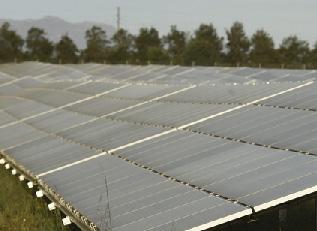

Services we offer:
• Online registration for energy projects;
• Assistance with the license application process;
• Facilitation between energy developers, Government Departments, Parastatals and Industry Associations;
• Support to developers to address capacity challemges at approving authorities;
• Technical advisory services;

Contact details for the dtic: Address: 77 Meintjies Street, Sunnyside, Pretoria, 0002 Contact numbers: +27 12 394 9599 Email: info@energyoss.gov.za
TAKE CONTROL
How to diminish cyber-related business risks with detection and response

14 AFRICAN BUSINESS QUARTERLY ISSUE 15 DIGITAL

DIGITAL
The latest edition of the Allianz Risk Barometer (shorturl. at/lowRX) confirms what organisational leaders have been experiencing. A digital world means more efficiency, lower cost, greater opportunity and much faster speed for business.
But it also comes with new risks—cyber risks—which top the Risk Barometer, followed by business interruption.
Some definitions limit cyber risks to cybercrime. However, there are other concerns under the category, such as data loss, negligent and malicious employee actions, digital weaknesses in supply chains, legacy technologies and governance failures such as publishing sensitive information publicly or not adhering to privacy legislation.
“It’s enough to make one’s head spin,” says Gerhard Swart, chief technology officer at cybersecurity company, Performanta. “Traditional businesses have a lot of risks to track. If we’re honest, most don’t and hope they don’t get into too much trouble.
“The problem with digital and cyber risks is that they tend to be present everywhere in a business, and by their nature can escalate very quickly. For example, if a point-of-sale platform or payment service goes down, it could stop transactions at several branches. But that’s a lot of extra elements to track, and most businesses don’t know where to start or what to prioritise.”
“ THERE IS NO MIRACLE SERVICE OR PROCESS THAT WILL ENCOMPASS ALL CYBER RISKS.”
ISSUE 15 AFRICAN BUSINESS QUARTERLY 15
DIGITAL

There is no miracle service or process that will encompass all cyber risks. But companies can start their cyber risk management journey on the right foot with a potent suite of technologies that also pave the way to take control of the digital era’s new challenges.
CYBER RISKS NEED VISIBILITY
A dive into the Allianz Risk Barometer reveals the most crucial cyber risks: data breaches, attacks on critical infrastructure, and ransomware. Those are primarily cybercrime risks—but if we take a step back, those same domains also affect data loss (intentional or accidental), failure of cyber infrastructure such as disconnected networks, and employee and partner actions.
It is a message that the cybersecurity world has been promoting for a while: digital is everywhere, and security is an integral part of digital environments. Where digital goes, security follows, and security can identify more risks than just cybercrime.
“Think of it this way: If you lose important business data, does it matter how you lost it? Of course, you need to know what happened. But whether the data went missing because a system crashed, an employee deleted it, or a criminal encrypted it for ransom, the outcome is often the same. This is why we ask businesses not to treat security as a separate function. Security risks and other digital risks are often related, and they often come down to one thing—visibility,” says Swart.
Many organisations do not have clear views of what is going on in their systems. Whether it is an outdated system close to collapse, an employee casually sending sensitive files to their personal email address so they can work at home, or someone trying to break into systems, visibility is the difference between dodging cyber blows and taking it on the chin.
Yet, complexity erodes visibility, and today’s digital companies have layers upon layers of complex systems, processes and relationships. Criminals love complexity. Like cracks in bricks and wood hide cockroaches, bad actors hide in the blind spots of digital complexity.
But visibility does not just address cybercrime. It exposes most cyber risks. And if you can address visibility issues on the cybersecurity
16 AFRICAN BUSINESS QUARTERLY ISSUE 15
level, you build the foundations for other types of visibility as well.
Detect and respond
To put that differently, if you improve security visibility, you start to improve other types of visibility. For example, security visibility of data encourages better overall data management. Security visibility of employee actions toward digital assets can also reinforce good governance and responsible practices. And security visibility of business systems supports
better general maintenance of those systems.
Better security visibility leads to better visibility of digital estates and activities, which helps companies manage their wider range of cyber risks. Yet, cybersecurity is already a demanding landscape of risks, so what is the best place to start and ensure these wider opportunities?
Swart recommends looking at extended detection and response, or XDR. “XDR is a

“THE PROBLEM WITH DIGITAL AND CYBER RISKS IS THAT THEY TEND TO BE PRESENT EVERYWHERE IN A BUSINESS, AND BY THEIR NATURE CAN ESCALATE VERY QUICKLY.”
security concept that combines different tools to actively detect problems and attacks. For example, it collects and examines a large amount of data from across a business. It looks at employee behaviours, system performance, activity logs and such things, analysing them for unusual patterns.
“But this is not spying. XDR isn’t Big Brother. It’s the very intelligent canary in the coal mine. It raises flags when something seems off, and it does this far more widely and quickly than any single system or team of humans ever could,” he explains.
XDR is a relatively new concept, only getting its name six years ago. Since its inception, technology providers have combined different security products and services to create the most effective forms of XDR. It is not a fixed product, but a collaboration between specific technologies, services and human skills. Taken as a whole, XDR represents a practical culture and philosophy for digital visibility— and that is why it is an excellent answer to cyber risk concerns.
Organisations can tackle cyber risks by focusing on the visibility of their digital world. XDR provides an excellent way to channel those goals and tackle the most concerning cybersecurity risks.
ISSUE 15 AFRICAN BUSINESS QUARTERLY 17
DIGITAL
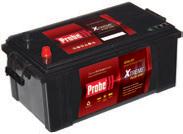









COEGA Special Economic Zone
- An International Award Winner and Leading SEZ in Africa
COEGA is a catalyst for the championing of socio-economic development, and an investment hotspot for industries with a global perspective.
Brought to you by the Coega Development Corporation.
PLUG AND PLAY TODAY
Located in the bustling city of Gqeberha in the Nelson Mandela Bay Municipality, the 9003-hectare Coega Special Economic Zone (SEZ), developed and operated by the Coega Development Corporation (Coega), is safe and secure, fully equipped with modern infrastructure, incentive programmes, and investor support services, alongside the region’s ready labour force capacitated by an on-site skills development and training centre. Recently, Coega won the African Business Award 2023 on Skills Training and Education, adding to its international awards of excellence.
These benefits for investors and clients form part of the Plug and Play model of Coega, providing services that enable quick turnaround times from development of infrastructure to operations, and meeting socio-economic development objectives.
The Coega SEZ sits on the main southern hemisphere east-west shipping routes, making it an ideal location for Transshipment, business process outsourcing (BPO), energy, automotive, agro-processing and aquaculture, and other manufacturing companies looking to expand their regional or international footprint. Furthermore, the Coega Business Process Outsourcing Park is equipped with modern state-of-the-art facilities, offering customisable space to meet user requirements at competitive rates. The SEZ is also served by two ports, with the deepwater Port of Ngqura as a designated hub for container traffic, while the Port of Port Elizabeth operates as a container, vehicle, breakbulk and bulk terminal.
LEADING THE WAY IN ENERGY
The Coega SEZ has successfully attracted over R 4.7 billion worth of energy projects that are operational and has implemented several other projects, including the Coega Solar Rooftop Project. The Coega Energy Strategy identifies approaches to managing the energy supply, demand, efficient usage, and investment in current and new energy technologies in a manner that is environmentally friendly, institutionally sound, socially acceptable and cost-effective, utilising the best mix of energy supply and demand options.
The Coega SEZ has also been chosen as the investment location for green hydrogen projects. Hive Energy, in Partnership with Linde Plc, plan to develop an estimated $4.6 billion large-scale green hydrogen and ammonia project in the Coega SEZ to produce an anticipated 780,000 ton/year of ammonia by 2026.
Coega leverages innovation, business ecosystems and strategic collaboration to enhance competitiveness and attractiveness, as an investor location of choice for energy projects, while ensuring that the SEZ remains relevant to the developmental trajectory of Southern Africa.
ONWARDS AND UPWARDS FOLLOWING 1st QUARTER PERFORMANCE
Coega welcomed four investors, with a combined investment value of R 385.2 million, to the SEZ during the first quarter of the 2023/24 financial year. The first is from MEC Commercial Trailers with an estimated total investment of R 370 million, set to create approximately 150 operational jobs and 200 construction jobs. The second is from Atlantic Glass with an investment of R 13 million, set to create 20 operational jobs. Romark Logistics, with a R 2.2 million investment, and CNSA Investment, concluded lease agreements to occupy two facilities at the Coega SEZ Multi-user Building. Romark Logistics is projected to create 14 operational jobs. CNSA Investment, a Chinese investor, will be storing solar panels and related goods thus, supporting energy related solutions required by South African consumers.
In our current economic climate, this is a noteworthy accomplishment that reflects Coega’s growth momentum. Despite various challenges, Coega has successfully attracted investment into the region, demonstrating its potential as a crucial driver of economic development, job creation, and overall economic growth.
HOME AQUACULTURE Coega’s accommodate production, Eastern of reticulation DRIVING Coega suppliers core zones and R12,7 Stettantis Follow Facebook: Corporation CoegaDevCorp
”
and Senior Economist for the Coega Development
Mr. Semiyou Rafiou.
“
– Head of Research
Corporation,
HOME TO ONE OF THE LARGEST LAND-BASED AQUACULTURE ZONES
Coega’s 440-hectare Aquaculture Development Zone (ADZ) site in Zone 10 can accommodate freshwater and marine aquaculture for various species, feed production, and processing and distribution to local and international markets. The Eastern Cape Provincial Government invested R 206 million for the development of the first 100 hectares of the ADZ, comprising important road networks, water reticulation services, electrical networks, and other enabling infrastructure.
DRIVING AUTOMOTIVE SECTOR GROWTH
Coega is geared to support automotive investors, assemblers, and component suppliers with a diverse range of services, allowing the companies to focus on the core business of manufacturing and distribution. Two of Coega’s 14 specialised zones are dedicated to the logistics and automotive sector, offering costeffective and comprehensive manufacturing solutions. The sector at Coega boast R12,7 billion, and taking into account the newly announced investment by Stettantis Automotive, this is expected to increase to R15,7 billion in 2023. Follow Coega for updates on investment opportunities, project news, and more: Facebook: CoegaDevCorp | X: @CoegaDevCorp | LinkedIn: Coega Development Corporation | Instagram: Coega Development Corporation | YouTube: CoegaDevCorp



Statistics South Africa (Stats SA), is one of the entities that has continued to measure the economic activity of Coega SEZ investors. Stats SA and Coega have had a partnership since 2017 for the statistical agency to measure investors’ economic activities. Stats SA has produced three reports to date on the Coega SEZ. The latest report is comprised of the assessment of the economic activities of investors in the Coega SEZ for the financial year 1 July 2020 to 30 June 2021. This report measured income, employment, capital expenditure, and value of imports and exports in the SEZ. The highlights indicated that the Coega SEZ investors made R 14,3 billion in income. The total income reflected an annualised increase of 9,0% compared to the income reported in the corresponding survey of 2018 (R11,0 billion).
Scan the QR code to read the latest Coega Census Report.
– Mr. Semiyou Rafiou.
“ “
Metallurgical Metals/ Automotive Out sour c i n g Proce s s Busi ne s s Chemicals Agroprocessing Logistics E nergy 11 investors, with a combined investment value of R 631.2 million, providing a total of 2 648 jobs 12 investors, with a combined investment value of R 1.33 billion, providing a total of 481 jobs 2 investors, with a combined investment value of R 18.17 million, providing a total of 1 529 jobs 12 investors, with a combined investment value of R 5.3 billion, providing a total of 2 321 jobs 1 investor, with an investment value of R 150 million, providing a total of 533 jobs
investors, with a combined investment value of R 3.93 billion, providing a total of 66 jobs 16 investors, with a combined investment value of R 600 million, providing a total of 1 800 jobs Coega Special Economic Zone (SEZ) currently has 58 operational investors, with a total investment value of R 11.96 billion, providing a total of 9 378 cumulative jobs Q4 (as at 31 March 2023) View the Coega Corporate Video View the Coega Census Report www.coega.co.za ISO 9001:2015 ISO 14001:2015 ISO 45001:2018 ISO 20000-1:2018 ISO 27001:2013 To locate your business at Coega or learn more about investment opportunities, email: invest@coega.co.za
Coega Focus Sectors
4
BUILDING CAPACITY , TOGETHER
How international banking from Mauritius is transforming the economic landscape in subSaharan Africa

22 AFRICAN BUSINESS QUARTERLY ISSUE 15 BANKING

ISSUE 15 AFRICAN BUSINESS QUARTERLY 23 BANKING
Thavin Audit, acting head of International Banking at Bank One (International.BankOne. mu), writes about the key role that Mauritius-based banks are playing in Africa by structuring transactions through their international banking divisions to shape investor interest and channel funds toward impactful projects being run by financial institutions, central banks, sovereigns and top corporates alike:
An International Monetary Fund working paper from April 2023 (shorturl.at/puvQR) estimates that sub-Saharan Africa could find itself caught in the crossfire as geo-economic fragmentation sees fault lines between nations deepening. It postulates that, in a world fully split into two isolated trading blocs, subSaharan Africa would be hit especially hard because it would lose access to a large share of current trade partners.
The report soberingly notes that about half of the region’s value of international trade would be affected in a scenario where the world is split between trading blocs centred around the United States and European Union, and another around China.
The report, however, holds out a ray of hope when it notes that deepening domestic financial markets can broaden the sources of financing and lower the volatility associated with excessive reliance on foreign inflows. It underlines that by upgrading domestic financial market infrastructure—including through digitalisation, transparency and regulation, and expanding financial product diversity—sub-Saharan African countries can expand financial inclusion, build a broader domestic investor base, and increase attractiveness to a larger set of external investors.
It is here we believe Mauritius has a pivotal role to play in supporting sub-Saharan African economies to realise their true growth potential by using its expertise as an international financial centre (IFC) to extend sophisticated financial instruments to fund the continent’s economic development.
Why are banks from Mauritius going into subSaharan Africa?
A case in point is the sub-Saharan African

strategy being pursued by Bank One for the last three years, coincidentally dating from just before the outbreak of COVID-19. I&M Group PLC (www.imbankgroup.com), a Kenya-listed financial services group holding 50% of Bank One—having a strong presence in key East African markets such as Tanzania, Kenya, Rwanda and Uganda, combined with significant demographic changes underway in subSaharan Africa—creates a compelling story to address rapidly expanding customer needs in the region. As such, one had to adopt the strategy of leveraging shareholder footprints in the region to provide solutions to both Mauritian and sub-Saharan African businesses looking to grow.
For instance, while the slogan of Bank One is to bring “African solutions to African challenges”, looking at sub-Saharan Africa, we know it is not an easy journey, as each country has its own characteristics, and these emerging economies are not rated as well as those from more advanced regions by credit agencies. However, if one looks at the space of financial institutions, central banks, sovereigns or top corporates where our shareholders sit—and scrutinise the individual entities within—it is clear that the probability of default for such large institutions tends to be very low due to the stringent regulations around the banking sector.
Hence, looking at the top-tier financial institutions in Africa, I believe they are comparable to the highest rated banks in the global arena. For instance, even if the Nigerian economy itself has unfortunately been downgraded to Caa1 from B3 by Moody’s as recently as February (shorturl.at/htyN1), its banks are still comparable to the best in the world.
As global banks search for international projects spread across the world, it creates a window for banks based on African soil, such as those in Mauritius, to leverage upon opportunities emerging on the continent. Indeed, Africa’s trade finance gap, estimated to be between US$80 billion to US$120 billion (shorturl.at/mpGN2), has widened further over the past decade, exacerbated by the disruption to global supply chains caused by the COVID-19 pandemic. In this space, it is only those that are too big to fail—large financial institutions, sovereigns and large corporates— that have been able to make a difference to high-impact but long-gestation projects on the ground.
Lessons from this journey
Post COVID-19, supply chains have been further disrupted, and demand is only now picking up. So, big banks based in key African economies need funding for their clients, and most letters of credit for trade finance range in tenor between 90 days to one year. That funding space gives banks in Mauritius an opportunity to leverage on those transactions efficiently. For instance, if banks in Nigeria or Tanzania have continuous trade finance requirements, Mauritius-based banks can fulfil those by putting together a small syndication.
In addition, Mauritian banks can leverage on speed of execution, project management skills and low turnaround time to deliver value to the development finance institutions (DFIs) that are seeking to fund projects in Africa.
Within the DFI funding the space, a key lesson for banks is that sustainable financing is the way forward. Operating from a Small Island Developing State that is heavily reliant on
24 AFRICAN BUSINESS QUARTERLY ISSUE 15
BANKING
Sabinet introduces African Industry Reports

Through its distribution partnership with Who Owns Whom (WOW), Sabinet offers unparalleled insights into South African and African Industries.
The Sabinet Link –Market Intelligence and Qualitative Contexts.
Related Content links to
news journals reference
legal content
African Industry Reports focused on South African industries will be linked to applicable acts and regulations. Seamlessly navigate between reports and legal content, enabling informed decisions.
In-depth insights, informed decisions for business analysts and academic researchers.
UNLOCK THE BENEFITS OF IN-DEPTH ANALYSIS AND KEY INSIGHTS INTO 25 INDUSTRIES ACROSS AFRICA.
Agriculture
Automotive & Parts
Aviation
Business Support Services
Chemicals & Fertilisers
Communication, Media & Technology
Community & Personal services
Construction
Education
Energy & Water
Financial Institutions
Fisheries & Aquaculture
Food & Beverage Forestry & Wood
Healthcare
Hospitality, Gaming & Entertainment
Manufacturing
Marine
Mining

Retail & Wholesale
Sanitation & Waste Management
Textiles, Clothing & Footwear
Transportation
The source reports are written by Who Owns Whom (WOW) according to Statistics South Africa (Stats SA) industry sector classification codes. WOW is an independent research organisation dedicated to producing exceptional, original research.
FIND OUT MORE DOWNLOAD BROCHURES
Mauritius has a pivotal role to play in supporting sub-Saharan African economies to realise their true growth potential
nature, one must be alert and on guard against extending finance to any project that is harmful to the environment. Addressing the climate crisis and reaching net zero emissions by 2050 is not going to be cheap, but to manage the increasing impacts of climate change on people’s lives, all countries including the subSaharan region, will need funding—and banks have a crucial part to play.
It is also critical to attend the right events and conferences that create the opportunity to network with right partners for the region. It is important for banks in Mauritius to invest time and effort into attending global trade reviews and leadership platforms, which provide the necessary space to build relationships, engage with various institutions including the regulators, and look for opportunities where Mauritiusbased banks can create impact financing and position themselves as responsible and trusted funders.
On this note, the AFSIC conference (www.afsic. net) last year has proven very successful for the Mauritian delegation. Our key takeaway from AFSIC was creating a window to structure transactions by dealing with best-in-class insurance counterparties to diffuse risk on Africa-centric transactions—in a process termed ‘risk deficient’ through insurance support. A best practice for all banks eyeing Africa would then be to collaborate with Moody’s-rated insurance companies on the platform for diffusion of risk, give relief on capital allocation, and make the structured transaction less risky for global partners.

WHAT IS THE IMPACT BEING ACHIEVED ON THE GROUND?
Back in 2020 when COVID-19 first broke out and Bank One was on its first-year trajectory of the long-term journey of its sub-Saharan Africa strategy, we witnessed pressing issues around shortage of forex for central banks amid deep disruptions in supply chains. As such, we pioneered a currency swap for central banks. The solution is scalable, profitable and replicable for other central banks in sub-Saharan Africa facing forex seasonality challenges.
Bank One invited other Mauritian banks to participate in the syndication to expand the space and resources within. Such currency swaps hold the potential to extend powerful assistance to the central banks of the concerned countries to come out of their forex shortages and build their currency reserves. Finally, the funds raised from the currency swaps made significant impact by helping the countries in question to finance food and medicines for their burgeoning populations.
Indeed, going beyond our immediate neighbours in East Africa, our experience has shown us that Mauritius-based banks are also well placed to support banks in West Africa, which are particularly struggling with setting the right frameworks in place and are not necessarily compliant with International Financial Reporting Standards, based on their adherence to the French Generally Accepted Accounting Principles instead. Thus, with most banks in West Africa being francophone, the fact that Mauritius is bilingual and has a legal framework that imbeds both English and French laws gives us the opportunity and competence to reach out to markets in
West Africa where we can help central banks structure their potential transactions.
In the non-banking financial institutions space, there are leading microfinance outfits in Africa that are being supported by Mauritius-based banks as funders. Here again, the Mauritius IFC is making a clear contribution toward inclusive financing to improve conditions for low-income groups in Africa: be it for buying a small vehicle; investing in home-based agriculture for self-consumption; or improving standards of living for children.
EXPLORING THE RIGHT SYNERGIES
Ultimately, as the international banking arms of Mauritian banks foray deeper into Africa, it is important for us to acknowledge that the right partners on this journey would be not only local banks in Mauritius but also investment banks in other countries. Given that the appetite for Africa by banks in Mauritius is limited, let alone those based internationally, we must be willing and able to share stories of lessons learnt and create pathways into Africa for other banks. As local banks in Mauritius, we may not have the biggest balance sheets, but we do have the knowledge and capacity to provide funding. We must build capacity in the space as, together, we can achieve broader and deeper impact.
It is only over time that we can slowly but surely build our way upward. Every bank has its own governance and credit appetite, but Africa is a success story that is waiting to happen—and Mauritius can definitely be a key player in accelerating Africa’s transition to higher growth and economic development by spreading the word.
26 AFRICAN BUSINESS QUARTERLY ISSUE 15 BANKING


Contact Us www ntgr co za Info@ntgr.co.za +27 14 5350 066 F o o t p r i n t S o u t h A f r i c a | B o t s w a n a D e m o c r a t i c R e p u b l i c o f t h e C o n g o M o z a m b i q u e | U g a n d a | Z a m b i a

ARMSCOR
A strategic partner of choice for defence and security solutions

COMPANY PROFILE
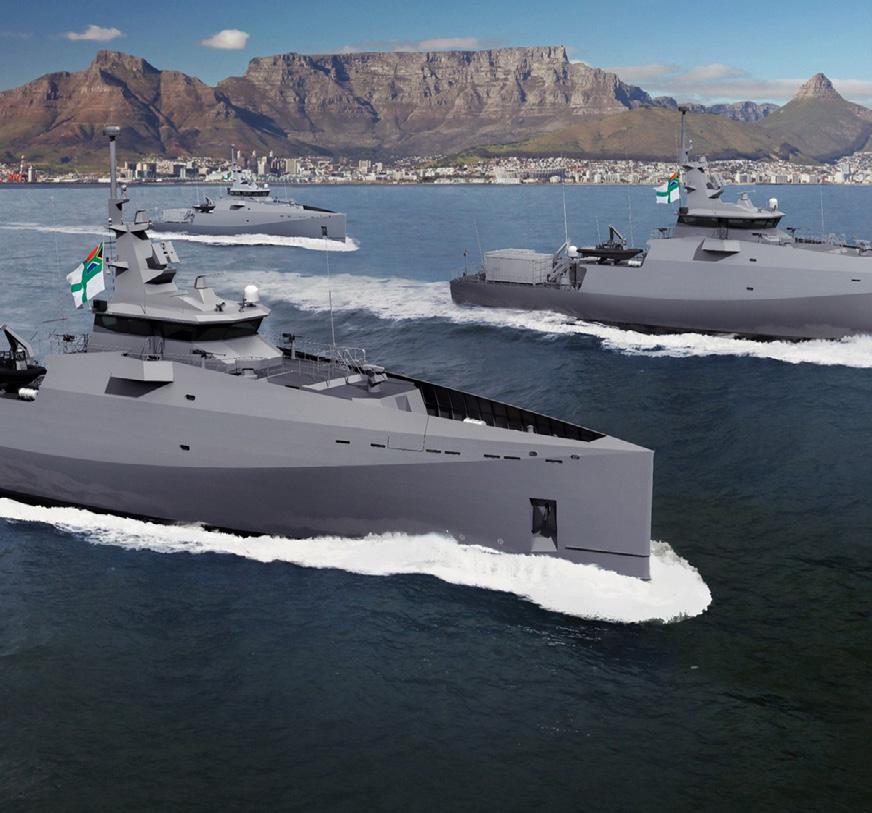


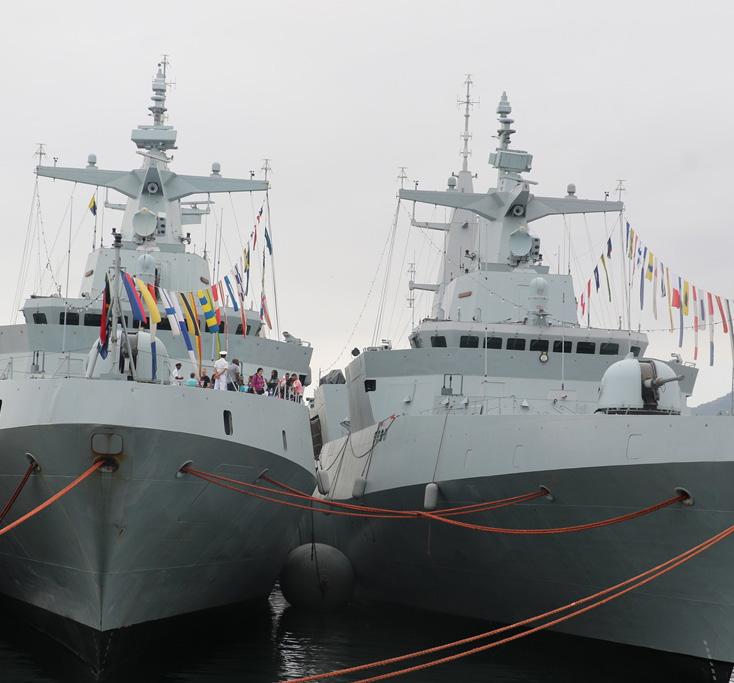
The Armaments Corporation of South Africa SOC Limited (Armscor) is an acquisition agency for the South African Department of Defence (DOD), and other organs of state and entities.
Armscor's mandate is to provide the armed forces with state-of-the-art defence matériel, delivering innovative defence solutions efficiently and effectively. The organisation manages the strategic capabilities of the DOD, producing research and vanguard technological solutions required to provide safety and security for South Africa, its citizens and the continent.
ARMSCOR’S CORE BUSINESSES
1. ACQUISITION
One of Armscor’s core businesses is acquisition. Its key functions include requirements analysis, technology development, design and development

of products and product systems, the industrialisation and manufacturing of mature products and product systems that fully meet user requirements. It also entails procurement of existing and qualified products, as well as the acquisition of product system support for user systems during the operational lifetime of the systems. The organisation has the capability to perform an independent, centralised coordination and management role for technology acquisition and technology commercialisation.
2. RESEARCH AND DEVELOPMENT
Armscor, through its Research and Development, is able to conduct defence research and scientific research, test and evaluation services, technology management, analysis and industrialisation, and intellectual property management services. The organisation has the capability to perform an independent, centralised co-ordination and management role for technology acquisition and technology commercialisation.
“The organisation manages the strategic capabilities of the South African Department of Defence”
3. NAVAL DOCKYARD
The dockyard provides repair and maintenance services to the SA Navy on various product systems from tugs, small craft, frigates to submarines. Maintenance and repair services cover both planned and ad-hoc projects. It is one of South Africa’s strategic national capabilities, where the country’s naval defence maintenance, repair and overall capabilities are housed.
Contact details:
Corporate Communication Division
370 Nossob Street, Erasmuskloof
X4, Pretoria, South Africa
Tel: +27 (0) 12 428 1911
E-mail: info@armscor.co.za
COMPANY PROFILE

BIG DISRUPTION ON OUR DOORSTEP
Tough economic headwinds provide exciting opportunities for agile, customer-centric fintechs XXXX 30 AFRICAN BUSINESS QUARTERLY ISSUE 15 FINANCE
At this time of year, there is usually a flurry of articles attempting to lay out trends to look out for in various industries over the coming months. This is a good exercise, as it gets one thinking about industries broadly and technology specifically. However, it would be remiss to embark on this exercise without first taking stock of where we are now.
For instance, the fintech ecosystem is currently in a period of stress, less so for incumbents but noticeably for newcomers.
This stress is a direct result of macroeconomic pressures piling up to generate headwinds for new market entrants. As we all know, when the macro picture is less than rosy, it affects play out on the ground. In summary, there is less money floating around: less money from investors and, most notably, less disposable income in the hands of consumers.
Let us take a moment to appreciate how this looks in the broader African context. Firstly, it means there is significantly less money knocking on the doors of new and innovative businesses that need investors.
In October 2023, a payments processor headquartered in France lost 53% of its value (shorturl.at/INW69)—this kind of scenario has a knock-on effect across borders. However, there is a massive opportunity for fintechs that have bootstrapped themselves up in the uniquely African context.
What does this opportunity look like? For starters, there continues to be a great deal of disruption in the market. Fintechs, mobile network operators (MNOs) and banks will approach the challenges and opportunities differently. The ones that emerge from this phase in a strong position will be those that have thought about the economics of their

proposition carefully, because the opportunity that presents itself in tough times is likely more scalable from an addressable market perspective.
On the other hand, those who react will focus on price. A war on price is a race to the bottom. On the contrary, the businesses and fintechs that get through the tough times will be those that focus on customer experience. It may be considered an intangible that sits between the bricks and cogs of a business, but it is crucial.
In difficult conditions, every business focuses on customers returning and using their products and services more frequently. This is not easy, or everyone would be getting it right. Customers with less money in their pockets

become more discerning, and in our experience are looking for a full basket of genuinely personalised customer experience where affordability is a crucial component, but most certainly not the only one.
We have learnt that speed, access, trust, convenience and safety in the payments space continue to be exceptionally important drivers in customers’ decision-making on where to spend their hard-earned money. At Mukuru (www. mukuru.com/sa), we build very tight feedback loops with our customers and the feedback we get time and time again is speed, ease of use and safety is primary to how they develop their consideration set.
Looking ahead, regulation will continue to play an important role in how the industry evolves. The Financial Action Task Force’s grey-listing of South Africa in February last year (shorturl.at/ktQS7) has had a significant impact on businesses such as ours. We are under increasing scrutiny, not because anyone thinks we present any more risk than before, but because accountable institutions must demonstrate that they are confident money is not being laundered or used for nefarious purposes. The result is that fintechs need to spend more time thinking and planning their products and must be tight in terms of the relationships they build with their customers.
ISSUE 15 AFRICAN BUSINESS QUARTERLY 31 FINANCE
The fintech ecosystem is currently in a period of stress, less so for incumbents but noticeably for newcomers.
Regulation is also expected to present immense opportunities, especially in southern Africa. South Africa, for example, lags other regions in the realm of mobile money. Legislation that is expected to come into play in 2025 will effectively form the framework within which e-money capabilities will be governed. This moment will be a significant game-changer for the region. The ability for more people to use e-wallets more frictionlessly will add immense value in the South African context and will fundamentally change the landscape of how money is stored, used and moved.
Looking toward this big disruption on our doorstep, businesses will approach the opportunity differently. There will be those who throw mud at the wall and see what sticks, whereas we believe the real winners will be those that remain crisp and precise with their customer propositions. In this context, we believe partnerships will be vital for stability and growth, where partners enter mutually beneficial symbiotic relationships. These can take many shapes and forms such as payment providers bridging the gap between the informal and formal sectors, solving a problem for fintechs that need ways to enable their customers to pay for goods and services, and where the payment provider gets access to millions of previously unreachable customers.
Digitisation and diversification will continue to be important trends in the coming months and years. Take a moment to consider the power that MNOs and banks have traditionally exerted in the formal payments ecosystem— fintechs that are agile can enter into partnerships with other fintechs to offer similar


32 AFRICAN BUSINESS QUARTERLY ISSUE 15 FINANCE

one-stop solutions to those currently offered by the MNOs and banks. This trend will see an equalisation of influence.
Lastly, those that prioritise customer needs and wants will emerge stronger. There are two schools of thought on how you digitise money. The first is that you place a wallet in someone’s hands and encourage them to use it (the traditional approach). The Mukuru approach— the approach of the more agile players—is to find a way to help people with their payment and remittance needs and then graduate them toward using a digital store of value as they develop trust in the brand and the technology.
These are divergent approaches, but in difficult economic conditions, our experience— which has seen us sign up 14 million customers across many countries—says it is better to listen to what customers want and then walk a journey with them as they become more sophisticated in their digital journeys. Our approach is to solve a problem and then gradually build trust and extend the services and products we offer, as opposed to building a shiny product and waiting for customers to arrive.
Andy Jury Chief Executive Officer Mukuru
Fintechs, mobile network operators and banks will approach the challenges and opportunities differently

ISSUE 15 AFRICAN BUSINESS QUARTERLY 33 FINANCE
THE FUTURE IS BRIGHT
FOUR TOP TRENDS TO WATCH IN THE AFRICAN ENERGY SECTOR IN 2024

XXXX 34 AFRICAN BUSINESS QUARTERLY ISSUE 15 ENERGY

The renewable energy sector is set to see innovation that will transform the way energy is accessed, stored and deployed across Africa.
Paul van Zijl, group CEO at Starsight Energy (starsightenergy.com), discusses four key trends that he thinks will profoundly shape the energy industry over the next year.
BATTERY BENEFITS FAR BEYOND BACKUP FOR BEHIND-THE-METER PROJECT S
One of the most significant shifts in solar technology revolves around the integration of battery energy storage systems (BESS), especially for behind-the-meter solar (also known as on-site solar).
Traditionally, batteries were seen primarily as backup storage when paired with a solar system, ensuring a steady power supply during cloudy days, nighttime or when the grid is unavailable. However, in 2024, the focus is vastly shifting toward load management, where batteries play a dynamic role in optimising energy consumption.
As the trend for the deployment of batteries across the continent grows, cutting-edge management systems will become a key part of solar installations with an integrated battery component. These systems use advanced algorithms to predict energy demand patterns. This allows for the strategic use of battery storage—discharging it during expensive peak times and charging it using solar energy or the grid during off-peak—to reduce the costly demand charges that come with variable tariff structures.
Along with enhancing the efficiency of solar systems, integrated battery storage solutions can also contribute to grid stability by reducing strain during high-demand periods.
When it comes to front-of-the-meter (or offsite) storage, BESS is also set to play a bigger role in the deployment of utility-scale renewable energy technology like wheeling , where power is generated at an offsite location (like a solar or wind farm) and transported using the available power network to different off-takers.
In South Africa, for example, the national energy provider Eskom announced the deployment of around 343MW in BESS projects (shorturl.at/jlqK8) as part of an overall 500MW BESS initiative aimed at addressing the country’s long-running electricity crisis. The systems will be in remote areas (with limited access to Eskom’s network), but still close to renewable energy plants built by independent power producers.
This collaboration between the public and private sectors supports more widespread deployment of utility-scale power and the adoption of renewable energy projects. By adding battery storage components to the national grid, businesses and consumers can gain quicker access to reliable electricity while the power utility can address peak energy demands more easily.
This also ensures the increasing amount of power generated from utility-scale solar projects can be stored and consumed outside of daylight hours to avoid stranded grid capacity.
The rise of sustainable off-grid solar solutions
Off-grid renewable energy solutions, including stand-alone systems and mini-grids, offer a unique opportunity to expand modern energy access services. The distributed nature of these systems allows them to be tailored to local conditions, tap into available renewable resources, deliver diverse energy services, and utilise local capacity to ensure long-term sustainability.
Integrated battery storage solutions can contribute to grid stability by reducing strain during high-demand periods
ISSUE 15 AFRICAN BUSINESS QUARTERLY 35 ENERGY
ENERGY
AS THE SOLAR INDUSTRY MATURES, A TREND TOWARD CONSOLIDATION WILL BECOME INCREASINGLY EVIDENT IN 2024.
We will see a rise in these solutions as more and more commercial and industrial businesses realise the value of effectively moving off-grid. This will be prevalent in three industries:
DATA CENTRES
Africa is a global hub for data centres. According to research from African Infrastructure Investment Managers (shorturl. at/kqCJ6), there is around 250MW of installed data centre capacity across Africa—with the demand for centres in Africa expected to exceed supply by 300% by 2030. These powerhouses of technology rely heavily on a steady and safe electricity supply. From operating to maintaining their vast cooling systems, large data centres simply cannot afford the risk of a grid collapse or any possible power interruptions. Power autonomy is the name of the game here, making battery storage a necessity from the get-go.
BANKING
While the prevalence of mobile financial services continues to soar on the continent, there is still a tangible need for brick-and-mortar banks and ATMs in countries where access to these services remains essential. These sites need to remain operational should there be any sort of grid collapse or catastrophic power failures—making an off-grid solution a nonnegotiable component of the future of banking in Africa.
TOURISM
With the rise of conscious consumerism and ecotourism, sustainability is fast becoming the differentiating factor for discerning travellers choosing their next holiday destination. Luxury lodges in popular destinations in East and southern Africa are fast moving toward fully off-grid solar battery operations to offer their guests uninterrupted access to power while boosting the lodge’s green credentials in the process.
As more and more businesses become aware of the benefits of off-grid solar, it is likely that we will see an even greater adoption of this technology in the coming year.
A REIMAGINED AGGREGATION MODEL
We will certainly see a shift toward aggregated solutions, wherein energy providers will consolidate diverse technologies and services into comprehensive packages in 2024. This trend is driven by the recognition that a holistic approach to energy solutions is not only more convenient for consumers, but also more effective in optimising energy production and consumption.
This can be done in several ways. For example, trading of electricity in South Africa allows a service provider of solar energy to buy and sell excess wind energy without having to invest substantial capital expenditure amounts. Similarly, instead of having gas-powered energy compete with renewable energy, the aggregation model will also allow providers of such services to aggregate their energy solutions and provide the client with a holistic offering.
The goal is to provide consumers with a seamless and integrated final product that maximises the benefits of renewable energy across various aspects of their daily lives. The real value for customers lies in a collaboration of providers that can meet their specific needs and power the entire energy life cycle.
TACKLING COMPLEXITIES THROUGH AN INCREASINGLY CONSOLIDATED SECTOR
As the solar industry matures, a trend toward consolidation will become increasingly evident in 2024. Larger energy companies will consider merging or acquiring smaller players, creating more robust and diversified entities. This consolidation is driven by the desire to achieve

36 AFRICAN BUSINESS QUARTERLY ISSUE 15


economies of scale, increase market share and foster innovation by pooling resources and expertise.
Consolidation in the industry is not limited to manufacturers, but extends to service providers, research and development firms, and energy management companies. By joining forces, these entities can tackle the complexities of the evolving energy landscape more effectively, driving down costs and accelerating the adoption of alternative energies across the continent.
This trend is fostering the emergence of holistic service providers capable of providing end-toend solutions that address the diverse needs of businesses, consumers and communities.
The recent market-milestone merger between Starsight Energy and SolarAfrica (solarafrica. com/merged-group) is a case in point. Customers in eastern, southern and western Africa can access our comprehensive mix of cost-effective solutions that provide power security and carbon reduction. These include solar energy, battery storage, wheeling and energy management, among others.
The future is bright. If 2023 was anything to go by in terms of transformation for the energy sector, 2024 will be marked by accelerated innovation and a collective commitment to harnessing the full potential of renewable energy that holds the promise of a more resilient, more sustainable and more tightly connected energy future for Africa.
ISSUE 15 AFRICAN BUSINESS QUARTERLY 37
ENERGY
IT’S ABOUT TIME
Working capital in two hours— a game-changer for South Africa’s SMEs

ENTREPRENEURSHIP 38 AFRICAN BUSINESS QUARTERLY ISSUE 15

ENTREPRENEURSHIP ISSUE 15 AFRICAN BUSINESS QUARTERLY 39
Last year, South Africa’s small and medium-sized enterprise (SME) owners found that access to working capital is their biggest stumbling block. This is according to a recent report from business-tobusiness funding innovator Lula ( www.lula. co.za), which surveyed hundreds of SMEs and entrepreneurs.
In response, Lula has recently streamlined its offerings to provide the quickest turnarounds for business funding products yet seen in the South African market.
“Once your application is approved, we will have the funds in your Lula bank account within two hours,” says Tom Stuart, Lula’s chief marketing officer.
“Time is money, and business owners are often stretched between running their business, managing teams, and ensuring they have the finances on hand to respond to market needs.”
With signs of recession looming large, today’s business landscape is more cutthroat than ever. The need for funding is time-sensitive. There are times when a quick same-day cash injection can make all the difference to your business strategy.
End-of-month is often a squeeze for SMEs, which must make sure there is cash on hand to cover staff payments and supplier fees, ahead of incoming payments.
When international currency exchange rates shift in your favour, for example, it allows you to replenish supplies more cheaply. The next day could be too late, as even a slight fluctuation in currency price would have a major impact on the price of the goods you want to import.
“For SMEs in the transport and vehicle sectors, it means that when a fuel price hike is announced, having the financial agility to refuel your fleet on the same day can result in massive savings,” says Stuart.
Faster access to capital also allows you to plan more accurately around significant international events that impact supply



40 AFRICAN BUSINESS QUARTERLY ISSUE 15
ENTREPRENEURSHIP
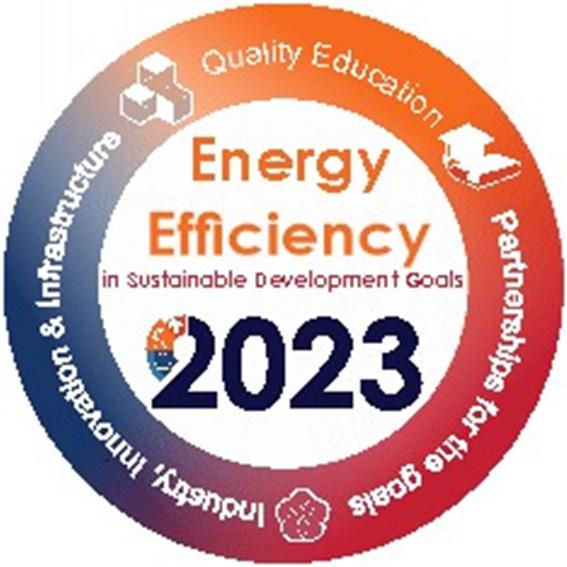

The Southern African Energy Efficiency Confederation (SAEEC) is the local recognized chapter of the Association of Energy Engineers® (AEE) and the first chapter established in Africa. AEE service more than 100 countries.
UPCOMING EVENTS

14 MARCH 2023
SAEEC Energy Awards and the Association of Energy Engineers (AEE) Certification Ceremony where we honor engineers and engineering companies for their dedication to the saving of energy.
> Energy Professional of the Year
> Young Professional of the Year
> Female Professional of the Year
> Energy Service Company of the Year
> Commercial Corporate Company of the Year
> Industrial Corporate Company of the Year
> Commercial Energy Project of the Year
> Industrial Energy Project of the Year
> IInnovative Project of the Year
> Energy Innovator of the Year
> Energy Management Leadership Award (ISO 50001 Registered)
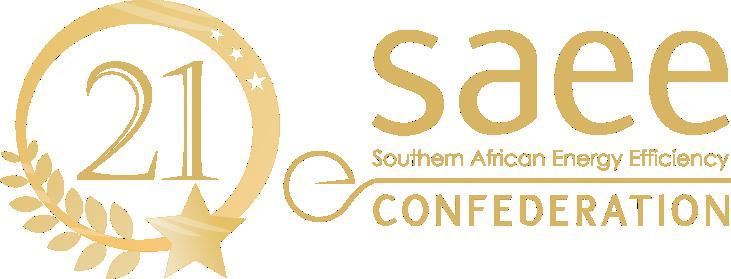

20-21 SEPTEMBER 2023
SAEEC 18th Annual conference.
Theme: Energy Efficiency in Sustainability and Development Goals in 2023

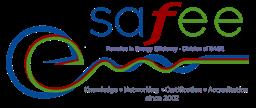


Contact us:
www.saeeconfed.org.za
go2energy@saeeconfed.org.za
Local Chapter of Interest groups within SAEEC

chains—such as Chinese New Year, Thanksgiving or bank holidays—which usually result in a delay in imports from that country.
Auctions and bidding situations are also scenarios where the ability to access nearinstant credit can give you an edge.
“Sometimes you need financing in a very short space of time. We get this. It’s why we’ve adapted our products by offering faster capital, and financial solutions that allow entrepreneurs to focus on growing their businesses instead,” Stuart adds.
Lula offers a digital banking solution tailored to the unique needs of South Africa’s SMEs, featuring Free and Unlimited account options.
“The Free account is well-suited for startups because it has no monthly fees, but incurs a per-transaction charge. The Unlimited account
is a better bet if you’re well-established and transacting in volumes. This account offers unlimited free EFTs, but has a set monthly fee of just R500,” Stuart explains.
Lula bank accounts are quick and simple to open. The process is fully online, with no branch visits needed.
You can link your existing bank accounts to your Lula account and have a handy dashboard to view all your business’s financial data all in one place.
You can also apply for funding without opening a Lula account. Businesses that go this route can still expect the cash in their account with a turnaround of one business day. By receiving business capital directly into a Lula account, SMEs can secure faster than ever access to additional funds.
Stuart points out that SME owners and entrepreneurs are cautiously optimistic about 2024. Lula has seen an upswing in applications coming from the retail, wholesale, information technology, vehicles sales, education, manufacturing and construction industries—indicating a promising surge in customer demand.
“Today’s unprecedented pace of technological innovation means SMEs are always on the lookout for new tech tools to give their businesses a boost.
“With the promise of small business funding in two hours set to bolster SMEs’ resilience amid competitive markets, Lula has further cemented its position as a leading innovator in the digital capital space. Speedy strategy and swift decisionmaking are key to business success,” concludes Stuart.
42 AFRICAN BUSINESS QUARTERLY ISSUE 15 ENTREPRENEURSHIP


FOR GOOD Q FOREVER

Clay masonry is a natural insulator against summer heat, winter cold, humidity and noise. With timeless appeal, impressive strength and maximum fi re resistance, clay brick looks beautiful for a lifetime.
CBASA represents clay brick & paver manufacturers across Southern Africa. We drive inclusive, sustainable practices in the industry while supporting our local producers, builders and architects.
Download free technical & construction guides at www.claybrick.org
CLAYBRICK.ORG FOECIOVEHT T H E CLAYBRICKINDUSTRY STYLE SUSTAIN SAVE SECURE

SEAS THE OPPORTUNITY
Uncovering investment and job-creation potential in the KwaZulu-Natal South Coast’s ocean economy
44 AFRICAN BUSINESS QUARTERLY ISSUE 15 OCEAN ECONOMY

ISSUE 15 AFRICAN BUSINESS QUARTERLY 45 OCEAN ECONOMY
Sustainable job creation that promotes conservation is crucial—not only in a country where tourism is a major economic factor but on a global scale in achieving the United Nations’ 2030 Sustainable Development Goals (sdgs.un.org/ goals). In South Africa, where there is more ocean territory than land, the ocean economy is an area burgeoning with employment opportunities.
According to the World Bank, the ocean— or blue—economy is the “sustainable use of ocean resources for economic growth, improved livelihoods and jobs, while preserving the health of the ocean ecosystem”.
In terms of fisheries, South Africa harvests around 600 000 tonnes of fish, providing food security to millions and more than 120 000 people with livelihoods. In addition, its 3 000-kilometre coastline, beautiful beaches and marine life make the South African coast a massive tourism drawcard.
With three marine protected areas (MPAs), an annual Sardine Run, the province’s highest number of Blue Flag Beaches, and the warm waters of the Indian Ocean, the KwaZulu-Natal South Coast’s 120km coastline is one of the country’s untapped ocean economies set to be unlocked.
The region boasts an abundance of marine life suited to recreational and commercial fishing, as well as tourism adventures. Working with the Department of Forest, Fisheries and Environment (DFFE), the South Coast Tourism & Investment Enterprise (SCTIE) is identifying challenges and uncovering opportunities for investment in this sector.
Opportunities in the fishing sector
The local fishing sector, from small-scale fishing to commercial ventures, managed to reap the rewards of a successful Sardine Run in 2023, with netting taking place since the start of June. This annual ocean spectacle, which is also an important element for the tourism economy, is just one of the aspects contributing toward the region’s fishing sector, with more potential set to be uncovered.
“With established operators like Adcan Marine Suppliers (shorturl.at/ouvO5) and Tightline Fisheries (www.tightline.co.za), the KZN South Coast is becoming a key contributor to the commercial fishery sector, supplying the hospitality and retail industries with quality seafood—but we feel more opportunity exists in terms of the international export market,”
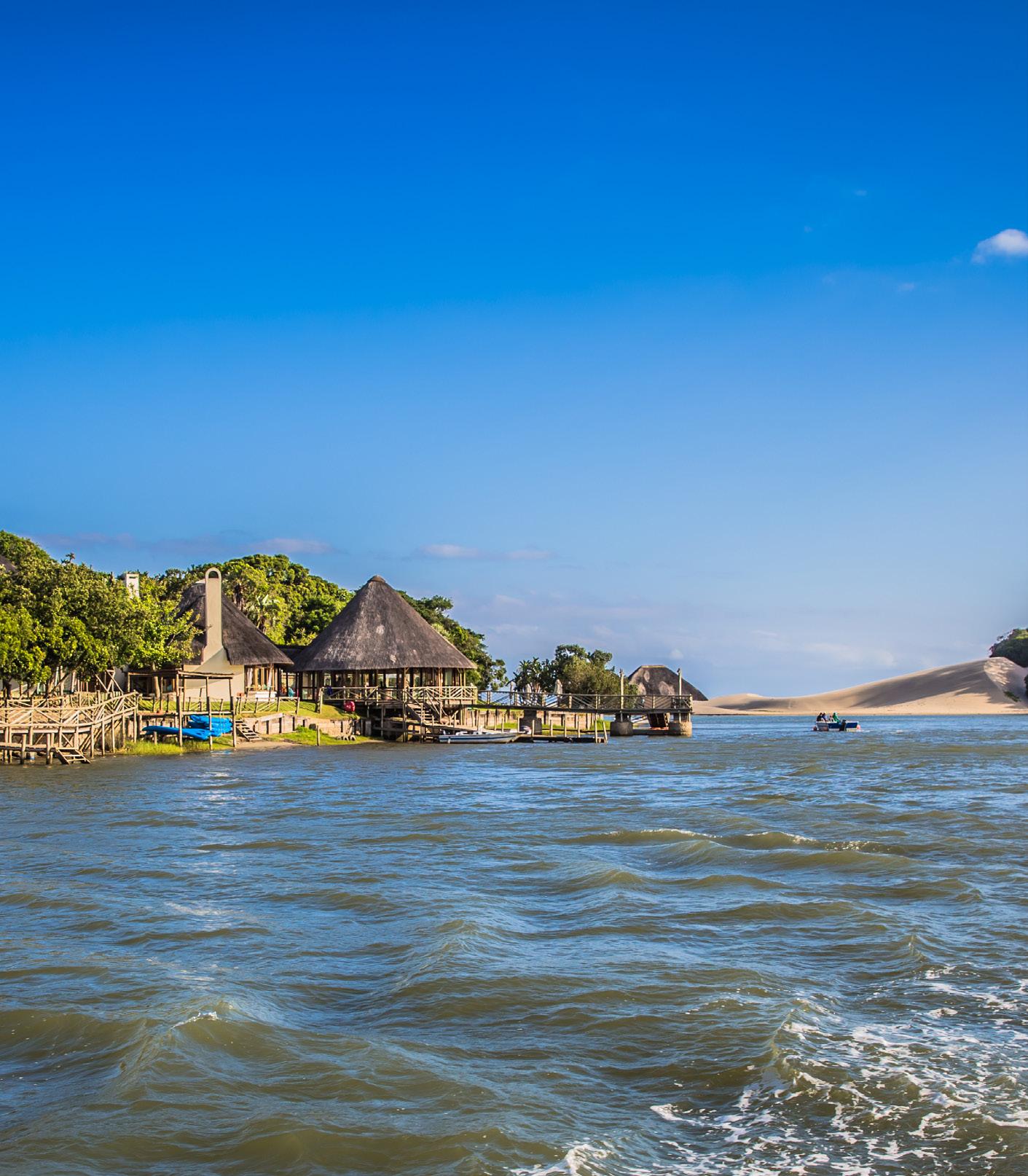
The region supports a large small-scale fishing sector, with seven registered small-scale co-operatives
comments Phelisa Mangcu, CEO of the SCTIE (www.investkznsouthcoast.co.za). “With the ocean economy a key sector for investment, we have been consulting with the DFFEE, which has a satellite office based in Port Edward, to pick up on trends in the fishing sector and uncover potential opportunities.”
The KZN South Coast, which has a coastline extending from Scottburgh to Port Edward, accesses the productive Indian Ocean waters, with hake, tuna, snoek and the famous sardines commercially fished from these shores. According to Adcan Marine Suppliers, the company processes around three tonnes of sardines a day during the winter months, for around six weeks, at its own processing unit.
The waters are also home to another highvalue species, the East Coast rock lobster, which is harvested here.
Recreational fishing also remains a strong drawcard, with visitors attracted to the KZN South Coast’s many fishing hot spots, as well as chartering boats for a day of deep-sea fishing. This will no doubt be supported by the DFFE’s recent announcement that fishing permits can be applied for online. The region’s three MPAs—Aliwal Shoal, Protea Banks and Trafalgar—also attract an abundance of marine life including rays, skates, sharks, dolphins and whales. This is recognised as a valuable resource for adventure and ecotourism, with cage diving all popular ocean activities.
46 AFRICAN BUSINESS QUARTERLY ISSUE 15 OCEAN ECONOMY

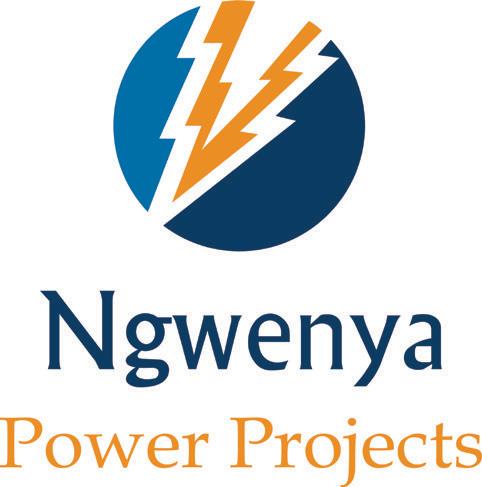
Our experience in connecting alternative energy projects speaks for itself. Whether Wind Solar or BESS we have a solution for you.
WHO WE ARE Qualified Experts Delivering On Time, Every Time.
Ngwenya Power Projects was started to address the need for a trustworthy specialist company that can serve the needs of its customers.
Founded in 2017 we are a proud Level 2 BBBEE contributor servicing the South African and International power industry.
Our team of Qualified Experts are capable of delivering all the services we offer to your satisfaction, on time, every time
MISSION
To value our customers by providing outstanding service on time every time.while expanding our services across South Africa and abroad.
CONTACT US:
+27 83 952 8507
admin@ngwenyapower.co.za
7 Mynhardt Street Gants plaza Strand
www.ngwenyapowerprojects.co.za
VISION
To be the leader in our field and to grow only by the needs of our customers.
Our team of Qualified Experts are capable of delivering all the services we offer to your satisfaction, on time, every time.
• MV and LV Cable Installations

• Reticulation projects, LV house connections
• Street Lighting
• Mini Substation Installations
• MV Cable Jointing and Terminations up to 33kV
• Cable Fault Finding and Testing
• Switchgear and Transformer Installations
• Substation Stringing and cabling
• Earthing Installation
• All your Electrical Needs
The KwaZuluNatal South Coast’s 120km coastline is one of the country’s untapped ocean economies set to be unlocked.
The region also supports a large small-scale fishing sector, with seven registered small-scale co-operatives: five based in Ray Nkonyeni Local Municipality and two in Umzumbe Local Municipality. Compliance is overseen by the DFFE, which indicates these local fisheries export a large portion of the marine food harvested to other countries—something that has largely declined since the COVID-19 pandemic, with the international demand from Asia impacted.
This decline in demand, as well as the notable decline in the quantity of fish harvested by local fishers, has prompted a proposal by the DFFE to conduct a pilot study to ascertain the possible contributing factors. Some of the challenges facing local suppliers attempting to export marine products include high tariffs, quality standards, and restrictions on the provision of permits. The SCTIE and DFFE have also noted the deterioration of fishing fleets and processing infrastructure; a shortage of skilled personnel with business acumen; and an educational gap that is leading to noncompliance in fishing regulations and a rise in illegal fishing.
“We are seeking to address these challenges at a provincial and national level so as to unlock the economic potential of the ocean economy even further,” says Mangcu. “This is being realised through Operation Phakisa (www.operationphakisa.gov.za), which is assisting maritime businesses to realise the full potential of our ocean economy; while at a local level, we’re achieving these goals through the launch of our Buy Local campaign, which
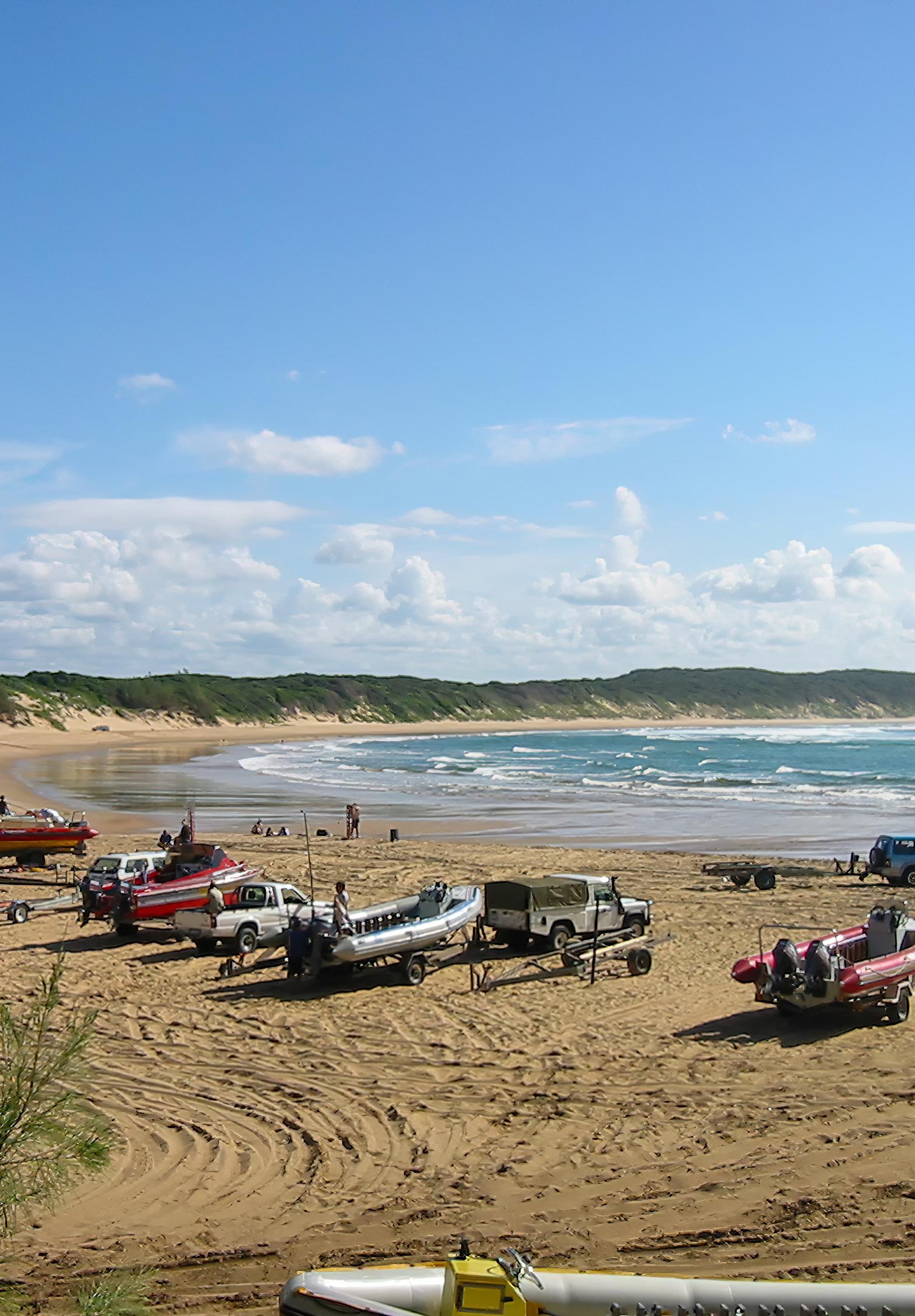
INVESTMENT OPPORTUNITIES IN THE KZN SOUTH COAST OCEAN ECONOMY
• Big boat builders for the commercial fishery sector
• Skills training in the repair and maintenance of boats
• Investment in next-generation ship- and boat-building technology services
• Provision of storage and logistics services
• Increased supply of seafood to local buyers
• Training of anglers with the intention to make them commercial fishers
• Fish packing in the commercial sector
• The expansion of launch sites along the KZN South Coast
• Training for boat/fishing guides on fishing charter trips
• Tourism-focused diving and fishing charters
• Whale watching and other ocean-based tour guides
encourages the support of local fisheries and ocean-based businesses.”
Providing local marine business support
Buy Local (shorturl.at/blnx8) forms part of the Department of Trade, Industry and Competition’s Buy Back SA initiative that encourages local business support. Companies that qualify for the Buy Local membership provide products and services of high quality, with at least 50% of the cost of production incurred within the KZN South Coast, and the business needs to create (or intend to create) employment opportunities for people within the region.
Buy Local members enjoy extensive marketing
exposure across all the SCTIE’s marketing channels; business support and networking opportunities; as well as member credibility and valuable information sharing. Beyond the direct benefits, the Buy Local campaign attracts investment, develops community relations, strengthens local value chains, and creates a more resilient economy.
“We’ve seen a lot of positive momentum in the Buy Local membership since the launch of the campaign,” says Mangcu. “The arrival of the Sardine Run in winter meant encouragement for local seine netters, charter boats and other members connected with the ocean economy. Membership continues to grow, which means uncovering even further potential in this and other investment sectors.”
48 AFRICAN BUSINESS QUARTERLY ISSUE 15 OCEAN ECONOMY




BETTER SKILLS, BETTER JOBS, BETTER WAGES
SHAPING THE SKILLS AND JOBS OF YOUTH IN MOZAMBIQUE WITH TECHNICAL AND VOCATIONAL TRAINING
XXXX 50 AFRICAN BUSINESS QUARTERLY ISSUE 15

Aurora Miranda is a young woman on a mission: connecting homes in her community to the power grid.
When she joined the Industrial Electronics vocational course at Instituto Médio Salesiano de Inharrime (shorturl.at/fhiCL) in Inhambane Province, Central Mozambique, she had little more than general knowledge and a vague idea about what to do with her future. In the course, she learnt practical skills to become an electrician, and plans to be self-employed.
“I want to solve problems in my community, like maintaining electric systems and connecting houses to the grid,” says Aurora. “I learnt that I could run my own business!”
Aurora is among the more than 43 000 students benefiting from a new competencybased curriculum transforming Mozambique’s technical and vocational education and training (TVET) system, with support from the World Bank’s fund for the poorest: the International Development Association (ida.worldbank. org). The new curriculum helps students learn the practical skills they need for their jobs. It also teaches them how to solve problems and develop a good work ethic. After all, this is what they need in today’s job market.
MASS-TRAINING TEACHERS TO UPSKILL YOUTH
Mozambique faces the pressing challenge of equipping its young and rapidly growing population with quality education and technical skills. With half a million youth entering the job market each year, most with limited skills, there is an urgent need to provide them with the training necessary to access good jobs and wages.
Over 70% of Mozambicans currently employed work in agriculture or non-paid family jobs. The country’s economy and job market need more professionals with specialised knowledge and technical skills, particularly those in fields like science, technology, engineering and mathematics (STEM).
To address this skills gap, Mozambique has been working with the support of the World Bank and partners to professionalise its educators. The goal is to enhance teaching and practical skills, ultimately bridging the gap between the skills demanded by the job
ISSUE 15 AFRICAN BUSINESS QUARTERLY 51
SKILLS DEVELOPMENT
market and those possessed by the country's youth.
“The great impact [of the new curriculum] is providing students with practical skills that enable them to pursue self-employment and succeed in the job market,” says Celso Rafael, a business management teacher and manager at Instituto Industrial e Comercial Estrela do Mar in Inhambane Province, who has trained more than 800 students.
“We are shaping lives,” he says. “We are contributing to changing people, families and the country—and I think this is priceless.”
UPGRADING THE ENTIRE SYSTEM
To make systemic change, the country needed enough teachers in higher education institutions trained in the competency-based training curriculum to ensure there are enough accredited institutions capable of providing this training. The Improvement of Skills Development Project (MozSkills) is helping achieve this.
MozSkills (shorturl.at/hotwW) is helping to improve the quality of higher education and TVET by training more teachers and managers on the new curriculum, with a strong focus on practical skills and STEM subjects. The project has successfully trained 66 trainers on competency-based training methodologies and enabled the accreditation of 10 higher education institutions to carry on the training of TVET teachers and managers—allowing them to reach professional certification and potentially scaling up its impact.
“Training managers and teachers have challenged us to shift from assessing students based on written exams to a skills-based approach that evaluates students’ knowledge, performance and productivity,” says Jessika Nhampossa, co-ordinator at the Universidade Save (unisave.ac.mz) Technical-Professional Teaching Centre (one of the 10 accredited institutions).
BETTER SKILLS FOR BETTER JOBS
Ivan Massango, a young man from central Mozambique, always wanted to be a professional builder, but lacked the skills. “This is why I enrolled in the Civil Construction vocational course. I needed to learn practical skills to become self-employed,” he says.
Mozambique faces the pressing challenge of equipping its young and rapidly growing population with quality education and technical skills.

For Ivan, vocational training is the basis for success, since it teaches theory and practice. “I had no skills when I joined. Today, I have a vision and a plan. I have formed a team of six qualified builders to work with me.”
The new curriculum promotes upskilling for self-employment and motivates teachers and managers to deliver quality training as they see students succeeding in new jobs and starting their own businesses.
“Every day, I teach future workers who arrive with no experience and become excellent professionals. As a teacher, it is gratifying to send a student for an internship with a company and to learn that the company employed them—and this happens often,” says Celso.
“Now, we teach how to do, be and behave. When teachers feel confident in what they teach, they deliver high-quality training. The result is highly qualified technicians to supply to our job market,” says Telma Inácio, who teaches mechanics at Maputo’s Industrial and Computing Institute.
More teachers, and better trained teachers, mean the youth are better prepared with the skills needed to access better jobs and wages.
To date, 1 806 teachers have received professional certification in competency-based training, and 400 staff (teachers and TVET school managers) completed the certification in management. More than a thousand more teachers are currently in training.
By the end of the project in December 2025, Mozambique will have more than 3 000 teachers ready to build a qualified and capable generation. Approximately 43 000 students now benefit from high-quality instruction provided by these well-trained teachers, with an uptick in female enrolment—a key priority for the project (shorturl.at/ov058).
"We need to tell girls that vocational training is not just for men. Women can do anything, and anything is possible!” adds Aurora.
The World Bank Group www.worldbank.org
52 AFRICAN BUSINESS QUARTERLY ISSUE 15
SKILLS SKILLSDEVELOPMENTDEVELOPMENT

Since Serving 1909
Formed in 1909, The South African Institute of Electrical Engineers sports ± 6000 engineering professionals.
Why Join Us
Our members are professionally engaged in various engineering activities, including academic research, manufacturing, electronics, telecommunications, measurement and control, mining, and power infra-structural services. Members make meaningful contributions to the quality of life in communities and the steady advancement of technology. Their efforts are acknowledged in many countries worldwide.
Corporate
Corporate Partners are invited to monthly forum meetings to discuss and brainstorm critical issues in South Africa and find solutions.
Corporate Partners receive:
• Access to 6000 engineering practitioners
• Rub shoulders with your industry peers
• Preferential rates on all SAIEE advertising platforms
• Access to the peer-reviewed Africa Research Journal
• Website Listing linking to your website
• Product Launch Platform
• Training Facilities
• Networking Opportunities
• Recruitment Administration
• Skills Development Courses
• Preferential CPD training course rates for your employees
• Assisted Corporate Social Responsibility
• Mentorship
• Offering SAIEE Students Workbased Integrated Learning (WIL)
• Bursary Fund Administration

To
ISSUE 14 AFRICAN BUSINESS QUARTERLY 53
enhance the
education
Company Profile Our Purpose Contact Us www.saiee.org.za minx@saiee.org.za SAIEE House, 18A Gill Street, Observatory, JHB
practice of electrical engineering in South Africa and the stature of our members through knowledge, networking, influence,
and communication. SAIEE
CORPORATE PARTNER TODAY!
Partners BECOME A

NEW HORIZONS
How new digital technology is revolutionising global relocations, redefining the way people move
54 AFRICAN BUSINESS QUARTERLY ISSUE 15 TRANSPORT DIGITAL TRANSFORMATION

ISSUE 15 AFRICAN BUSINESS QUARTERLY 55 TRANSPORT DIGITAL TRANSFORMATION TRANSPORT DIGITAL TRANSFORMATION
TRANSPORT
The world is undergoing a digital revolution, and its impact is being felt across various industries. One sector that has experienced significant transformation is global relocations.
In this era of technological advancements, companies like Crown Relocations South Africa (www.crownrelo.com) have harnessed the power of technology to revolutionise the way people relocate around the world.
From artificial intelligence–powered relocation platforms to virtual-reality home tours, from blockchain-enabled secure document management to data analytics for optimising relocation processes... technology has truly become a game-changer in the global relocations industry.
AI-POWERED RELOCATION PLATFORMS
Gone are the days of tedious paperwork and manual processes. With AI–powered relocation platforms, the entire relocation process has become streamlined and efficient. These platforms utilise intelligent algorithms to automate tasks, provide personalised recommendations, and offer real-time assistance.
Crown Relocations South Africa’s advanced relocation platform, for example, leverages AI to analyse customer preferences, match them with suitable locations, and even suggest the most convenient routes for transportation.
VIRTUAL-REALITY HOME TOURS
Relocating to a new country often involves finding a new home. Thanks to VR technology, individuals can now explore potential residences without physically being there. VR home tours provide a realistic and immersive experience, allowing individuals to view multiple
“Gone are the days of tedious paperwork and manual processes.”

56 AFRICAN BUSINESS QUARTERLY ISSUE 15 TRANSPORT DIGITAL TRANSFORMATION
DIGITAL
TRANSFORMATION

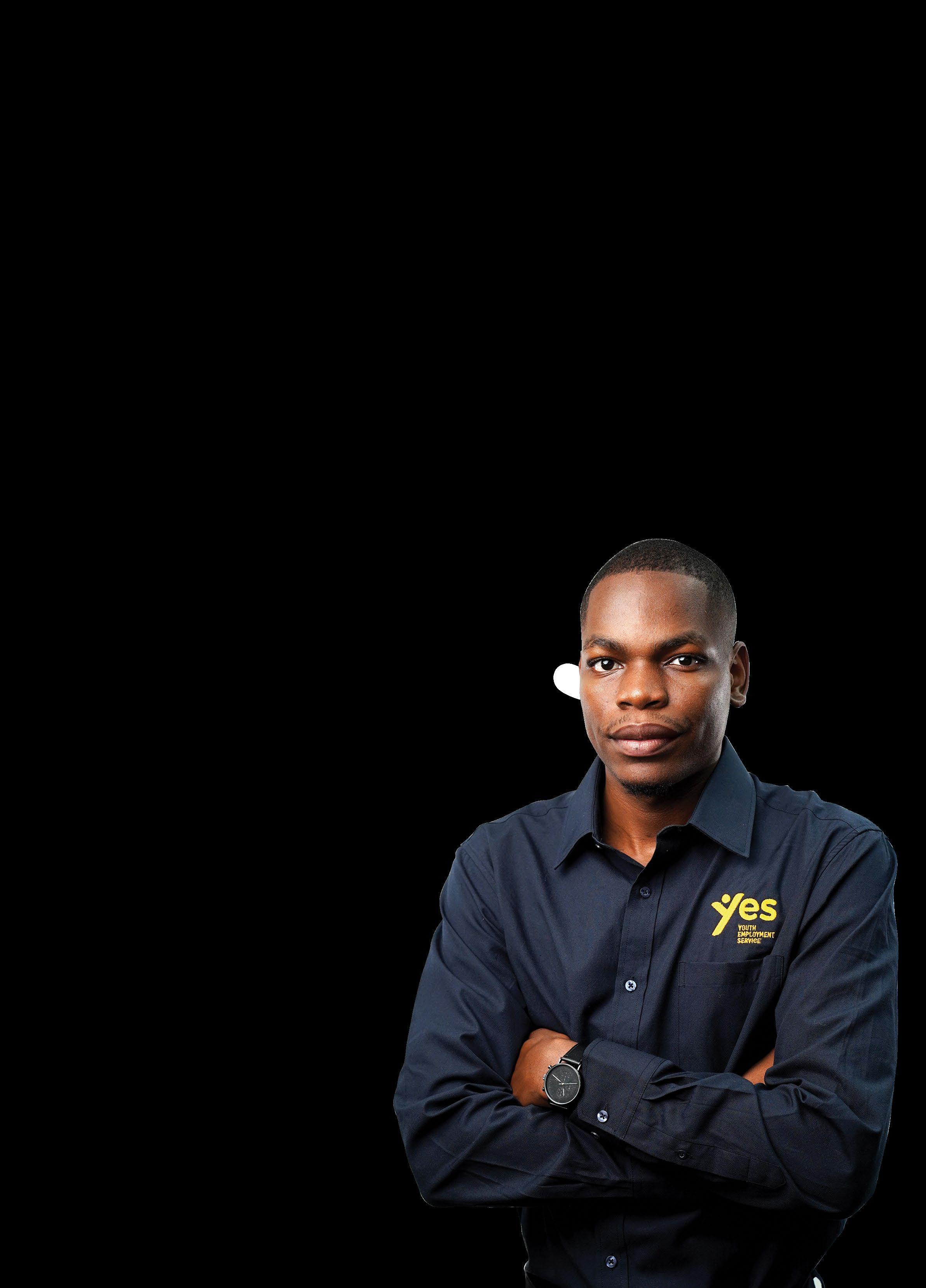

properties from the comfort of their current location.
Crown Relocations South Africa’s VR home tours enable clients to virtually walk through properties, examine details and make informed decisions, saving time and effort—and avoiding nasty surprises when letting or buying property from afar.
BLOCKCHAIN FOR SECURE DOCUMENT MANAGEMENT
The security and privacy of personal information are of utmost importance during relocations. Blockchain technology has emerged as a reliable solution for secure document management.
By utilising decentralised and tamper-proof ledgers, Crown Relocations South Africa ensures sensitive documents such as passports, visas and contracts are securely stored and shared. Blockchain enhances transparency, reduces the risk of fraud and provides peace of mind to clients during their relocation journey.
DATA ANALYTICS FOR PROCESS OPTIMISATION
Data analytics plays a crucial role in optimising
relocation processes. By analysing vast amounts of data, companies can identify patterns, trends and bottlenecks to improve operational efficiency.
Crown Relocations South Africa leverages data analytics to assess customer feedback, monitor performance metrics and continuously refine its relocation services. This data-driven approach enables the company to deliver personalised experiences and anticipate customer needs, ultimately enhancing overall satisfaction.
FURTHER AHEAD
These advancements are just a glimpse of the transformative power of technology in the global relocations industry. However, they represent a paradigm shift that is reshaping the way individuals and companies approach the relocation process. With the ongoing development of technology, we can anticipate even more exciting innovations in the future.
Looking ahead, e-packing could become a reality with smart handheld devices that allow users to provide voice commands and interact with virtual assistants. This would streamline the packing and unpacking processes, further enhancing efficiency and convenience for individuals and businesses relocating internationally.
“Blockchain technology has emerged as a reliable solution for insecure document management.”
Customer portals have become increasingly user-friendly, providing individuals with a centralised platform to access all relevant information and manage their relocation journey. These portals offer features such as real-time tracking, communication channels with relocation experts, and personalised task lists—empowering clients with greater control and visibility throughout the process.
In the grander scheme of things, the role of technology in revolutionising global relocations cannot be underestimated. AI–powered relocation platforms, VR home tours, blockchain and data analytics are just a few examples of how technology has transformed the industry.
With continued advancements on the horizon, the global relocations sector is poised to deliver even more efficient, personalised and seamless relocation experiences for individuals and businesses worldwide.
Crown Relocations South Africa stands at the forefront of this technological revolution, leveraging innovation to redefine the way people move and settle into new horizons. Personal advisers combine hundreds of years of experience, keeping in touch with customers regularly, offering helpful guidance and working with customers to understand any concerns they may have.
Alongside this personal touch, the company's proprietary Smart Tech helps put customers in control when they need to be, with solutions that give them the ability to control the details of their move from their phone—even when they are on the move.
Ian Pettey Managing Director: Africa Crown Relocations
58 AFRICAN BUSINESS QUARTERLY ISSUE 15
TRANSPORT DIGITAL TRANSFORMATION

EVOLUTION TECH
IDTechEx report finds that removing rare-earths drives demand for copper in electric vehicle motors

60 AFRICAN BUSINESS QUARTERLY ISSUE 15 TRANSPORT MANUFACTURING

Electric motors are a core component of electrification in the automotive market. The market has heavily relied on rare-earths for the permanent magnets used in these motors but, as many will be aware, there is a drive to eliminate these rare-earths due to their price volatility and environmental impact.
Alternative motor technologies can often present a new and increased demand for copper. However, this trend can be offset somewhat by improvements to winding efficiency and copper utilisation that have been seen in recent years. Regardless, the growing electrification of the automotive market will drive a 3.1-fold increase in copper demand for electric vehicle (EV) motors in 2034 compared with 2023.
IDTechEx’s report, “Copper Demand for Cars 2024–2034: Trends, Utilization, Forecasts”, analyses the key trends in the automotive market that will impact copper demand, including traditional components like the wiring harness and auxiliary electric motors, and emerging technology like electrification components (batteries, motors, power electronics, high-voltage cables), and autonomy (sensors and computing).
The report considers technology evolution and provides forecasts within each of these components for copper demand between 2024 and 2034.
WHERE IS COPPER USED?
A motor consists of a stationary component (stator) and a rotating component (rotor). In general, the stator will consist of a steel stack with copper windings that are used to
generate an electromagnetic field. The rotor materials vary depending on the technology.
Permanent magnet motors include magnets in the rotor, induction motors include copper or aluminum bars, wound rotor motors include further copper windings, and reluctance motors are predominantly steel.
ELIMINATING MAGNETS INCREASES COPPER
Induction motors have moved from being a popular drive motor to being mostly reserved for secondary drive applications. Depending on whether they have a copper or aluminium rotor, they can increase the copper content of motors compared to permanent magnet options.
The wound rotor motor is proving to be the go-to magnet-free option, and the use of copper windings on the rotor significantly increases the copper content of the motor, with some examples presenting more than double the copper of a comparable permanent magnet motor.

THE GROWING ELECTRIFICATION OF THE AUTOMOTIVE MARKET WILL DRIVE A 3.1FOLD INCREASE IN COPPER DEMAND FOR EV MOTORS IN 2034 COMPARED WITH 2023
There are alternative motor technologies that could keep copper similar to permanent magnet motors; for example, the reluctance motor’s rotor is predominantly steel and does not add copper or aluminium. However, these have traditionally had power density, acoustic noise and efficiency challenges.
There are several avenues for improvement here, with several players working on this type of design, but it is yet to be demonstrated in a mass-manufactured EV.
The more emerging axial flux motor presents very high-power density and, therefore, Von a copper content per kW of power basis, provides a much lower copper demand.

ISSUE 15 AFRICAN BUSINESS QUARTERLY 61 TRANSPORT MANUFACTURINGTRANSPORTMANUFACTURING
RELATIVE COPPER CONTENT OF ELECTRIC MOTORS USED IN ELECTRIC CARS (SOURCE: IDTECHEX)

WINDING TECHNOLOGY TO REDUCE COPPER
The prior discussion relates to the rotor, but there are efforts to improve the copper utilisation of windings in the stator. Traditionally, these windings are made of many individual small round wires wound together around the stator.
In 2021, hairpin-type windings took a similar global market share in EVs to round wires and actually overtook round wires in 2022. Hairpin winding involves square/rectangular wires being used, increasing the fill factor of the slots, making better use of the space available, and reducing the amount of extra copper windings that are left hanging at either end of the motor.
A higher fill factor can be used to increase the amount of copper mass per motor, or more effective filling can reduce the overall length (and hence, copper content) of the motor for the same performance.
The next stage of evolution involves having these hairpin windings pre-wound so that each bar does not need individually inserting and welding. This improves manufacturability, enables more stator poles, and further reduces the overhanging end windings. This process has been demonstrated by companies like Schaeffler ( www.schaeffler.com), Lucid
“There is also potential for copper to be replaced by aluminium in stator windings. ''
( lucidmotors.com) and BorgWarner ( www. borgwarner.com), which has a similar concept called 'S-winding'.
There is also potential for copper to be replaced by aluminium in the stator windings. Aluminium has an overall poorer volumetric performance, requiring a higher volume of aluminium for the same performance as copper. The motivation to substitute aluminium for copper is that aluminium is lighter and less costly than copper.
Despite this, for the majority of applications, IDTechEx expects copper to remain as the primary stator winding material beyond some specific scenarios where volumetric motor performance is not as critical.
OUTLOOK FOR EV MOTOR COPPER DEMAND
While there have been, and will continue to be, incremental improvements to the efficiency with which copper is applied within an electric motor, the rapidly growing EV market creates large new demands for copper in EV motors. This will be
compounded somewhat with a greater share of magnet-free motor designs hitting the market, with players like BMW and Renault utilising wound rotor motors—and tier 1 suppliers such as ZF ( www.zf.com), MAHLE ( www.mahle.com), Vitesco Technologies (www.vitesco-technologies.com) and others producing wound rotor designs.
IDTechEx’s report builds on its “Electric Motors for Electric Vehicles 2024–2034” (shorturl. at/bkBCD) report to provide an in-depth look at motor technology's impact on copper utilisation, predicting a 3.1-fold increase in copper demand for EV motors between 2023 and 2034. The report also predicts that trends like electrification and autonomy will drive a 4.8% compound annual growth rate in copper demand until 2034 for the automotive market.
To find out more about the report, including downloadable sample pages, visit www.IDTechEx.com/CopperForCars.
Dr James Edmondson Research Director IDTechEx
62 AFRICAN BUSINESS QUARTERLY ISSUE 15 TRANSPORT MANUFACTURING
TRANSPORT MANUFACTURING

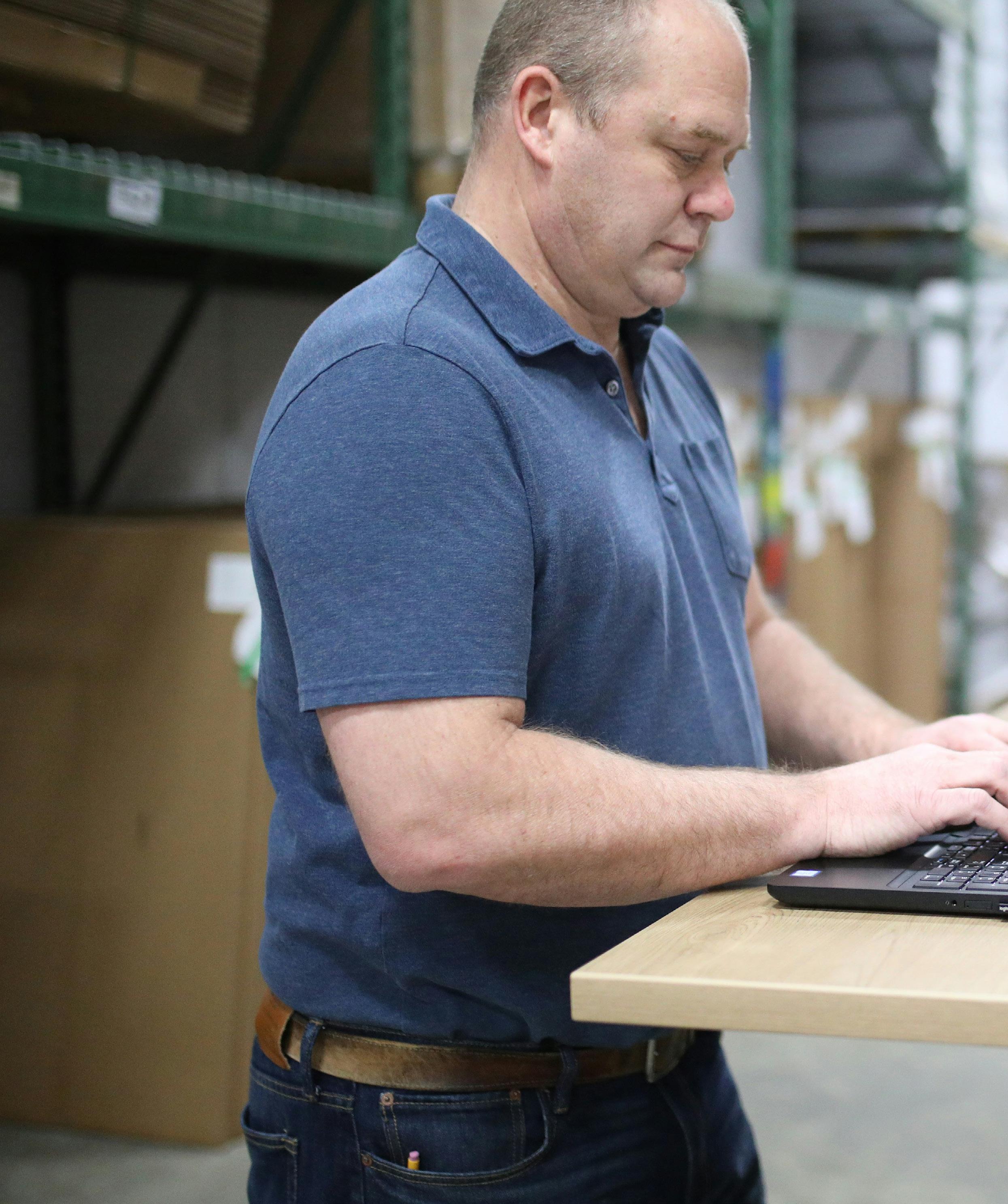
64 AFRICAN BUSINESS QUARTERLY ISSUE 15 TRANSPORT SUPPLY CHAINS
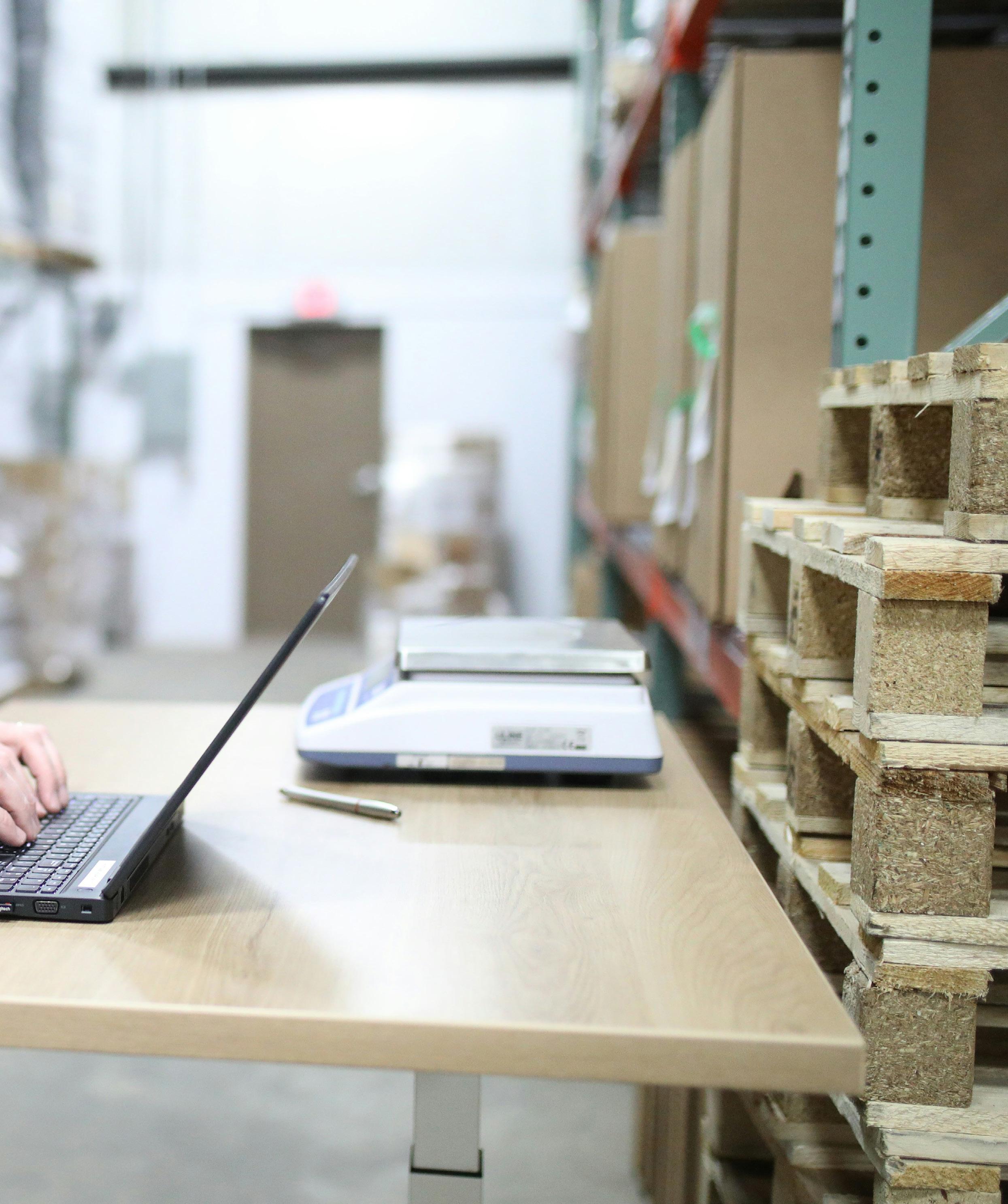
AFRICAN ADVANTAGE
Optimisation through ERP intelligence: allowing richer visibility and monitoring of performance, raw material availability, shipping and more
ISSUE 15 AFRICAN BUSINESS QUARTERLY 65 TRANSPORT SUPPLY CHAINS
Findings contained in a new report by the United Nations Conference on Trade and Development (UNCTAD) indicate that Africa’s economies have the potential to become major players in global supply chains.
The “Economic Development in Africa Report” (shorturl.at/alEKO), released in mid-August, states that given the continent’s vast resources of materials needed by the technology sector, it is perfectly positioned to service demand.
Minerals and metals like aluminium, cobalt, copper and manganese are essential components of the latest technologies.
“Africa also offers advantages such as shorter and simpler access to primary inputs; a younger, technology-aware and adaptable labour force; and a burgeoning middle class, known for its growing demand for more sophisticated goods and services,” the UNCTAD report adds.
In light of this positive outlook, it has become vital for African countries to optimise their supply chains to a global standard.
Enterprise resource planning (ERP) solutions are playing a significant role in this process.
ERP intelligence gives supply chain managers real-time insights into demand patterns, inventory, supplier performance and even distribution so they can make the best possible decision for the company.
Procurement professionals also benefit, as this software offers tremendous visibility into aspects like raw material availability and supplier delivery. It puts them in the enviable position of being able to improve sourcing strategies and negotiate the best terms with suppliers.
It does not end there, either, says Stephen Howe, a director at South African Sage business software and implementation specialist, Times 3 Technologies (T3T).
“The ERP system benefits everyone: from production managers to quality control and inventory teams. By having greater insights, they can all optimise their performance to build an even stronger supply chain.”
The advanced analytics tools embedded in the ERP solution process analyse real-time data, meaning that trends, patterns and any anomalies can quickly be identified and addressed.
The intelligence also tracks key performance indicators such as lead times, on-time delivery rates and inventory turnover. Dashboards and reports visualise these metrics, enabling quick assessment of performance.
Howe believes the solution’s demand forecasting capability will be particularly useful to African countries as they play a greater role in global supply chains. “This solution helps organisations anticipate fluctuations in demand and adjust production and procurement accordingly,” he says.
An ERP solution like Sage X3 is geared toward supply chain management aspects like purchasing, inventory and warehousing, sales and customer service as well as financial functionality—in other words, almost every aspect of the supply chain.

“It has become vital for African countries to optimise their supply chains to a global standard.”

66 AFRICAN BUSINESS QUARTERLY ISSUE 15 TRANSPORT SUPPLY CHAINS TRANSPORT SUPPLY CHAINS
INNOVATING THE FUTURE WITH ONE INNOVATION AT A TIME
Pioneering Excellence in Manufacturing and Beyond
In a world driven by technological advancements and innovation, Boniswa Manufacturing, a division of BONISWA GROUP, is a shining beacon of excellence in manufacturing. For years, we have remained at the forefront of the industry, pushing boundaries and setting new standards. Today, we proudly glimpse our journey, accomplishments, and vision for the future in this exclusive publication. Boniswa Group boasts a team of highly skilled professionals with extensive experience in the telecommunications industry. With a proven track record of delivering innovative solutions and services, we possess the expertise to meet our clients' diverse requirements and expectations.
Unveiling Excellence and Innovation
Since our inception, Boniswa Manufacturing has been synonymous with quality, precision, and cutting-edge technology. Our commitment to delivering exceptional products and services has earned our clients' trust throughout Africa. Innovation is the heart of Boniswa Manufacturing. We continuously invest in research and development, ensuring our products are technologically advanced and environmentally responsible. Our state-of-the-art manufacturing facilities harness the power of automation and sustainable practices, setting industry benchmarks for efficiency and ecofriendliness.
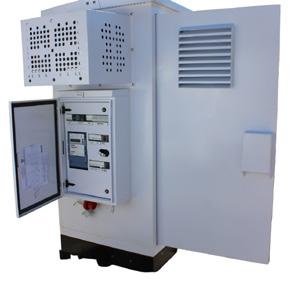
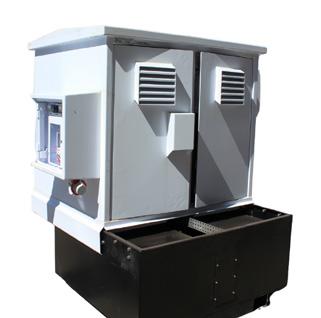

PARTNERSHIPS AND THE FUTURE OF MANUFACTURING
Our journey wouldn't be possible without the strong partnerships we've cultivated, from collaborating with industry leaders to nurturing emerging talent. As we look ahead, our vision for Boniswa Manufacturing is clear - to continue leading the charge in innovation, sustainability, and excellence. ation, and sustainability will guide us towards a brighter tomorrow.
Our Flagship products
Following a very high rate of vandalism of base stations in Southern Africa, our engineering team of manufacturing division has designed vandal-proof high security semi-subterranean transmission cabinets for telecom operators in Southern Africa.
Key Features & Benefits of Boniswa’s semi Subterranean Cabinets (High Security Cabinet)
• The cabinet can accommodate radio equipment from the top five Original Equipment Manufacturers (OEM) to provide 2G, 3G, 4G and future 5G services.
• Each door is secured and only accessible by use of Electronic Locking system using Bluetooth and OTP system to open the cabinet doors.
• Dual enclosure design keeps Lead Acid batteries safe below ground level or aboveground, inside a false plinth, making it exceptionally hard for anyone to reach for batteries.
• This specific cabinet is manufactured using 4mm mild/stainless steel, while the doors are 2mm thicker (6mm).
• The Base housing batteries can be further reinforced with inhouse developed anti-grinding panels, for high-risk area deployment.
• Its compact footprint of 1.4m X 1.2m makes it a must-have for confined space.
• It is compact, efficient, energy-saving and helps keep batteries safe.
CONTACT US
Boniswa Group
Boniswa Group



GLOBAL REACH, LOCAL COMMITMENT
With a global footprint spanning multiple continents, we are proud to be a part of communities worldwide. Our commitment to local development extends beyond business, as we actively engage in corporate social responsibility programs, supporting education and sustainable practices. We believe in making a positive impact wherever we operate
JOIN US ON THIS JOURNEY
In closing, we invite you to join us on this exciting journey of innovation and progress. As we strive to improve the world through innovative manufacturing, we remain dedicated to our core values of integrity, quality, and responsibility. Together, we can build a future that is both prosperous and sustainable. For more information about Boniswa Manufacturing and to explore our latest advancements, please visit our website, www.boniswa.co.za or contact our dedicated team at info@boniswa.co.za. We thank our valued clients, partners, and employees for their unwavering support, and we look forward to a future filled with new opportunities and achievements.



“The ERP system benefits everyone: from production managers to quality control and inventory teams.”
T3T (www.t3t.co.za), a Platinum Business Partner for Sage in South Africa, has also produced a series of Sage X3 add-ons to offer African—and, indeed, international—companies even greater functionality.
One worth noting is T3T’s Sales Budgeting Module. This add-on offers an intuitive, creative way to budget by period and attributes such as Product and Customer.
“Sales projections, forecasts or estimates of total sales volumes and values are automatically calculated based on current actual values and then projected forward,” Howe explains. “This can be filtered by region, sales representative, product, customer and more. Projected volumes and values can be manipulated based on weighted days, allowing for fluctuations based on seasonality or known events or trends.”
Once a forecast is created, a growth expectation is generated, facilitating the finalisation of an accurate, achievable sales budget for the following year at both a volume and value level.
“Being able to integrate data from various stages of the supply chain to create a holistic view of the entire process is making a huge difference to companies, and we certainly expect to see more African firms making use of this technology as they gain a greater foothold in the global market,” Howe says.
T3T's subscription cloud-based financialmanagement applications and services enable businesses to tailor a solution covering finance, procurement, distribution, inventory management and manufacturing, as well as facilitate payroll and human resources functions.
68 AFRICAN BUSINESS QUARTERLY ISSUE 15 TRANSPORT SUPPLY CHAINS TRANSPORT SUPPLY CHAINS


OUR SERVICES
We offer our clients a diversified and integrated selection of services that includes the following:
Board and CEO Search
Senior Executive Search
Emerging Leader Search
Talent Planning and Research
IT CONTRACTORS PLACEMENTS

Focus
Chief Executive Officers | Board of Directors | Advisory Boards
C Level executives | Business Leaders | Vice President/Director/MD |
Partner and Principal
Client Managers | Project Managers | Analysts/Associates |
Senior Managers
Talent Mapping | Executive Assessment | Leadership Personal Branding | Team Leader and Executive Coaching Solutions
We also focus on IT recruitment. Our top Talent Acquisition Specialists and Recruitment Consultants have extensive experience within the IT industry and assist employers with the placement of contract, permanent, temporary and freelance placements. Should you be looking to hire IT or Telecoms staff, submit a vacancy or contact us either online or via call, a recruiting agent will get in touch and discuss your recruitment requirements.
OUR EXPERTISE
Public Sector & State Owned Enterprises
International Non-Governmental Organisations
Audit, Research and Development, Forensics and Investigations
Agriculture
Logistics and Infrastructure
Professional Services and Academia
LEARNING AND DEVELOPMENT OFFERING
Energy
Fast Moving Consumer Goods (FMCG)
Financial Services (Investments, Asset Management, Banking and Insurance)
Industrial and Mining
Life Sciences and Healthcare
Telecommunication and Technology
Ndosi KaMagaye offers diversified consulting, training, facilitation and accreditation services. We assist organizations to improve their performance, primarily through the analysis of existing human capital development needs – resulting in joint development of innovative, cost effective and client specific plans and solutions for improvement. To deliver meaningful, quality material and content, we have partnership arrangements with reputable international training and training research firms. We harness a broad range of expertise and associates in order to facilitate a good match of team and task to ensure outstanding client exper ience. Ndosi KaMagaye generally brings its own, proprietary methodologies or frameworks to guide the identification of problems, and to serve as the basis for recommendations for more effective or efficient ways of performing business tasks.
www.ndosikamagayesp.co.za
We have a team with diverse skills that recruit across various industries, including but not limited to: info@ndosikamagayesp.co.za
GOING GREEN
How climate-neutral mobility can ensure sustainable economic growth on the African continent

70 AFRICAN BUSINESS QUARTERLY ISSUE 15 TRANSPORT SUSTAINABILITY
Unlocking sustainable economic growth in Africa requires a vision for climateneutral mobility on the continent, and this vision must emerge from within African countries. This is the key finding of a new discussion paper by the German development agency GIZ (www.giz. de), and the think tank Agora Verkehrswende (www.agora-verkehrswende.de).
The paper, titled “Leapfrogging to Sustainable Transport in Africa: Twelve Insights into the Continent’s Sector Transformation” and which is based on in-depth discussions with experts in Africa, aims to stimulate robust international dialogue on this topic.
Ingrid-Gabriela Hoven, a managing director of GIZ, observes: “A sustainable transport sector in African countries must be accessible to all, and climate-friendly. It requires both international attention and African solutions.”
The paper offers 12 insights concerning the structures and capacities for climate-friendly mobility that could be created on the African continent, while also spotlighting the need to avoid reliance on car-friendly development and fossil fuels—a mistake made by other countries. In the fields of spatial planning and transport infrastructure development, it is therefore crucial to consider to the goals of climate protection, social justice, quality of life, and crisis resilience.
“A sustainable transport sector in African countries must be accessible to all, and climatefriendly.”

XXXX ISSUE 1 AFRICAN BUSINESS QUARTERLY 71 TRANSPORT SUSTAINABILITY
It is crucial to consider to the goals of climate protection, social justice, quality of life, and crisis resilience
THE 12 INSIGHTS ARE:
1. Net-zero mobility can ensure sustainable economic growth.
2. A successful transition to sustainable transport requires clean energy and more equitable and efficient mobility
3. Creating fairer and more efficient mobility is the key to creating healthy, sustainable and livable cities.
4. The paratransit sector is essential for the sustainable design of urban and rural mobility services.
5. Digital data can ensure the transition to sustainable transport keeps apace with dynamic development in Africa.
6. Social justice is a basic precondition for sustainable transport.
7. Electric transport is the most efficient way for Africa to shed its dependence on fossil fuels and achieve net-zero mobility.
8. The motor vehicle industry and African countries must work together to create added value in the domestic economy.
9. Africa possesses enough renewable energy to power the global transition to sustainable transport.
10. The electrification of rail and road makes it possible to decouple the volume of trade from the level of freight transport emissions.
11. Climate protection and resilience are the foundations for the development of Africa’s transport infrastructure.
12. It is the joint responsibility of national governments and international investors to co-ordinate financing decisions.
Christian Hochfeld, director of Agora Verkehrswende, comments: “If African countries are to pursue climate protection goals, they must be able to determine their own strategies and solutions. The transformation must also be economically worthwhile for them. They have contributed the least to global warming, but will be strongly affected by the impacts. This augments the responsibility of the Global North to invest with partners from Africa in a more sustainable future.”
STRONG PROSPECTS
African countries have a tremendous opportunity to tap into the potential offered by electric vehicles, renewable energy and digital transformation. The continent has superb conditions for the generation of wind and solar energy.
Instead of permanently importing highconsumption and high-emission combustion vehicles, African countries could build up their own industries for the production of electric vehicles and battery cells. The necessary
raw materials are available in sufficient quantities on the continent.
There is also extensive potential for the further development of informal bus services by electrifying bus fleets and integrating them into digital mobility platforms. A sustainable transport system is an important prerequisite for effective and safe mobility, despite foreseeable climate change impacts. It would also minimise the contribution made by Africa’s rapidly growing transport sector to global warming.
GIZ and Agora Verkehrswende hope to strengthen capacities for sustainable mobility planning. To this end, GIZ will be organising further co-operative formats within the scope of the GIZ project Rethinking Transport (shorturl.at/krwxO).
Download the full discussion paper at shorturl.at/qxBKT

72 AFRICAN BUSINESS QUARTERLY ISSUE 15 TRANSPORT | WOMEN
SUSTAINABILITY
TRANSPORT





For Quality Release Oils ... ALSO AND Formulated For Specific Applications Creating Concrete Solutions! Curing Compounds • Epoxy Adhesives • Epoxy Grout • Joint Sealants • Non Shrink Grouts • Pre Cast Repairs • Water Proofing • Bonding Agents • Chemical Anchors • Concrete Bonding • Concrete Crack Repairs • Concrete Release Agents • Concrete Repair Mortars • 7049 Ashak Constrctn FP Feb’24 African Business Quarterly • Tel: + 27 11 822 2320 • Fax: + 27 11 822 2354 • e-mail: cindy@ashak.co.za
LAYING THE TRACKS
Private-public partnerships are the most viable solution to improving transport infrastructure in South Africa

74 AFRICAN BUSINESS QUARTERLY ISSUE 15
TRANSPORT INFRASTRUCTURE
Rapidly soaring prices for essential consumer goods are quickly outpacing the average South African’s wallet. But as the government and various industries continue the search for solutions to a bevy of issues driving up prices, it is vital to recognise the essential role that the infrastructure development sector could play in making transport—and hence, consumer goods—more affordable.
Transport can account for up to 10% of products’ total costs under normal circumstances as goods move from farms, factories or ports to the rest of the country. However, the transport sector is currently besieged by volatile fuel prices, lingering COVID-19 disruptions, security issues such as theft and hijackings, toll costs, border delays, and high offloading times.
Additionally, obstacles such as outdated and ailing infrastructure in transporting are playing further havoc on logistics costs.
The infrastructure industry has the potential to ease some of this pressure by resolving a multitude of infrastructure issues that make it more difficult and expensive to transport goods.
Due to the size of this undertaking, the private sector has a major role to play in helping to fund and lend expertise to large-scale infrastructure construction projects that will have a lasting impact on the public transport sector. And private-public partnerships (PPPs), especially, are the most viable solution to not only overcoming these public funding restrictions but to ensuring projects can roll out rapidly for maximum impact.
EFFICIENT TRANSPORT SOLUTIONS
South Africa’s road and rail networks play a crucial role in transporting consumer goods from ports, farms and factories throughout the country. Which option businesses opt to use depends largely on the type and quantity of the product they need to transport.
Rail transportation is generally more affordable for longer distances due to its higher capacity and lower fuel consumption,
Repairs to existing rail infrastructure, and efforts to upgrade and expand rail networks, will amount to billions.
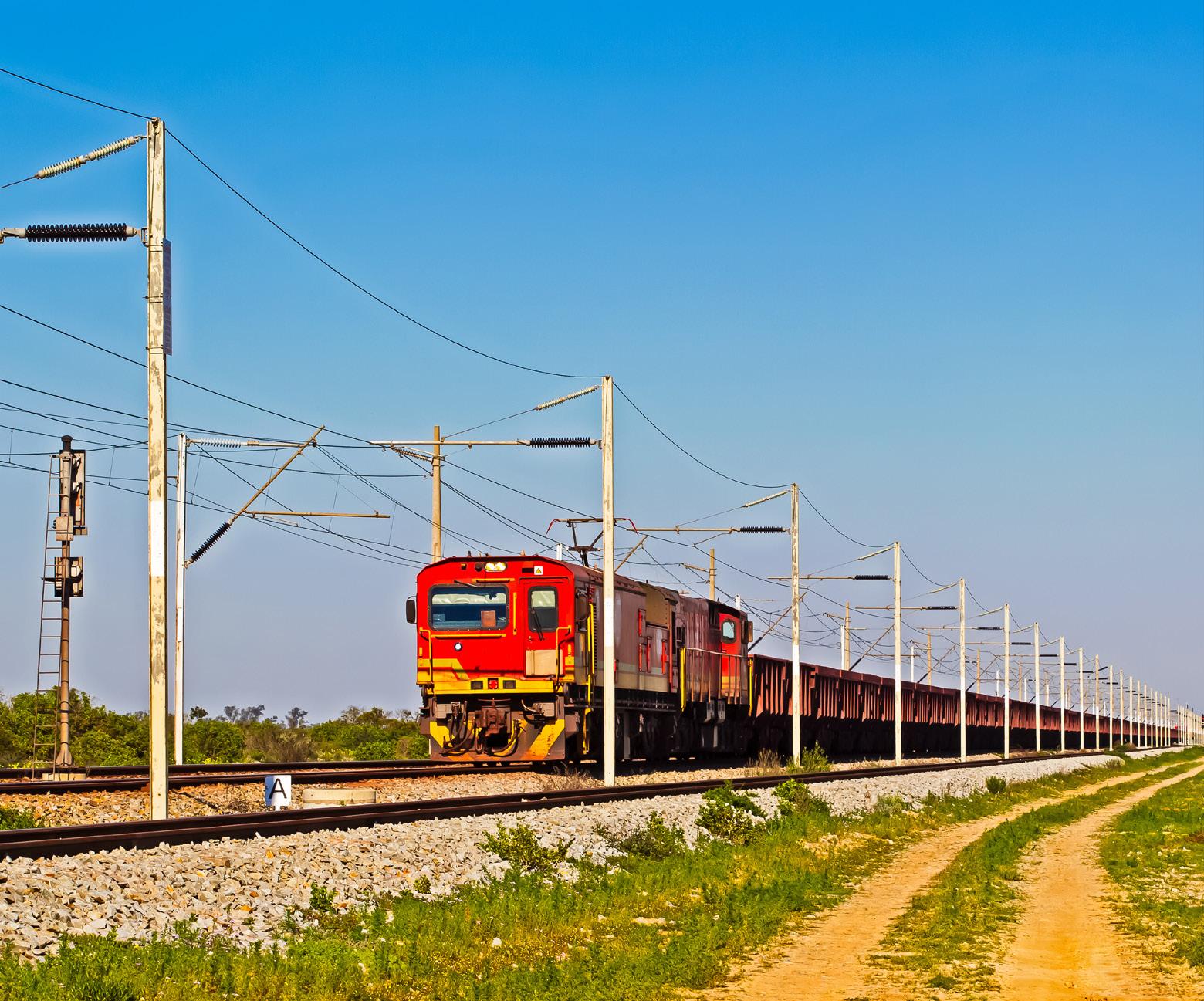
although its inherent rigidity makes it difficult for businesses to ship lower quantities of goods easily and quickly.
Road transportation is cost-effective over shorter distances and offers greater flexibility, speed and adaptability, but is less effective over longer distances. Rail is, theoretically, the ideal method to transport goods from ports to central South Africa—but due to the limitations inherent to rail systems, businesses choose to use road-bound trucks.
Repairs to existing rail infrastructure, and efforts to upgrade and expand rail networks, will amount to billions. But, once completed, this would save the country considerably more in the long term. That notwithstanding, the government cannot complete this immense undertaking without the technical expertise,
labour power and financial support of the private sector.
LEVERAGING ADVANCEMENTS IN TECHNOLOGY TO OVERCOME TRANSPORT OBSTACLES
Several challenges must be addressed to make both rail and road transport more practical, efficient and cost-effective. These include improving service delivery, enhancing availability and reliability, and accommodating just-in-time systems whereby companies only transport the exact amount of goods needed for sale—saving storage costs and wastage.
Advanced tracking technologies can also be implemented on rails and roads, and the data
ISSUE 15 AFRICAN BUSINESS QUARTERLY 75
TRANSPORT INFRASTRUCTURE TRANSPORT INFRASTRUCTURE
used to provide valuable insights into traffic or load patterns, congestion points and usage rates. For example, real-time tracking data may show that a particular road is consistently congested and indicate the need for additional lanes or alternative routes. This may also indicate where additional rail networks would be most effective.
Real-time tracking and route optimisation technologies can also help integrate new infrastructure projects with existing ones. For example, when developing a new rail line or road, these technologies can help ensure it effectively serve the areas with high demand and seamlessly connect with existing transport networks.
These technologies can also be used in the construction and maintenance of transport infrastructure. For instance, route optimisation
can help in planning the transportation of construction materials to the site, making the construction process more efficient. Similarly, real-time tracking can aid in monitoring the condition of infrastructure and scheduling timely maintenance.
Private sector infrastructure developers like Gap Infrastructure Corporation (www.gic. co.za) play a pivotal role in bringing these innovative solutions to longstanding national issues like slow and inefficient transport systems. By improving and expanding our country’s roads and rails, we can substantially improve delivery times and lower costs— helping to drive down high consumer goods inflation and stimulating economic growth through enhanced efficiency.
Roelof van den Berg CEO: Gap Infrastructure Corporation
Obstacles such as outdated and ailing infrastructure in transporting are playing further havoc on logistics costs
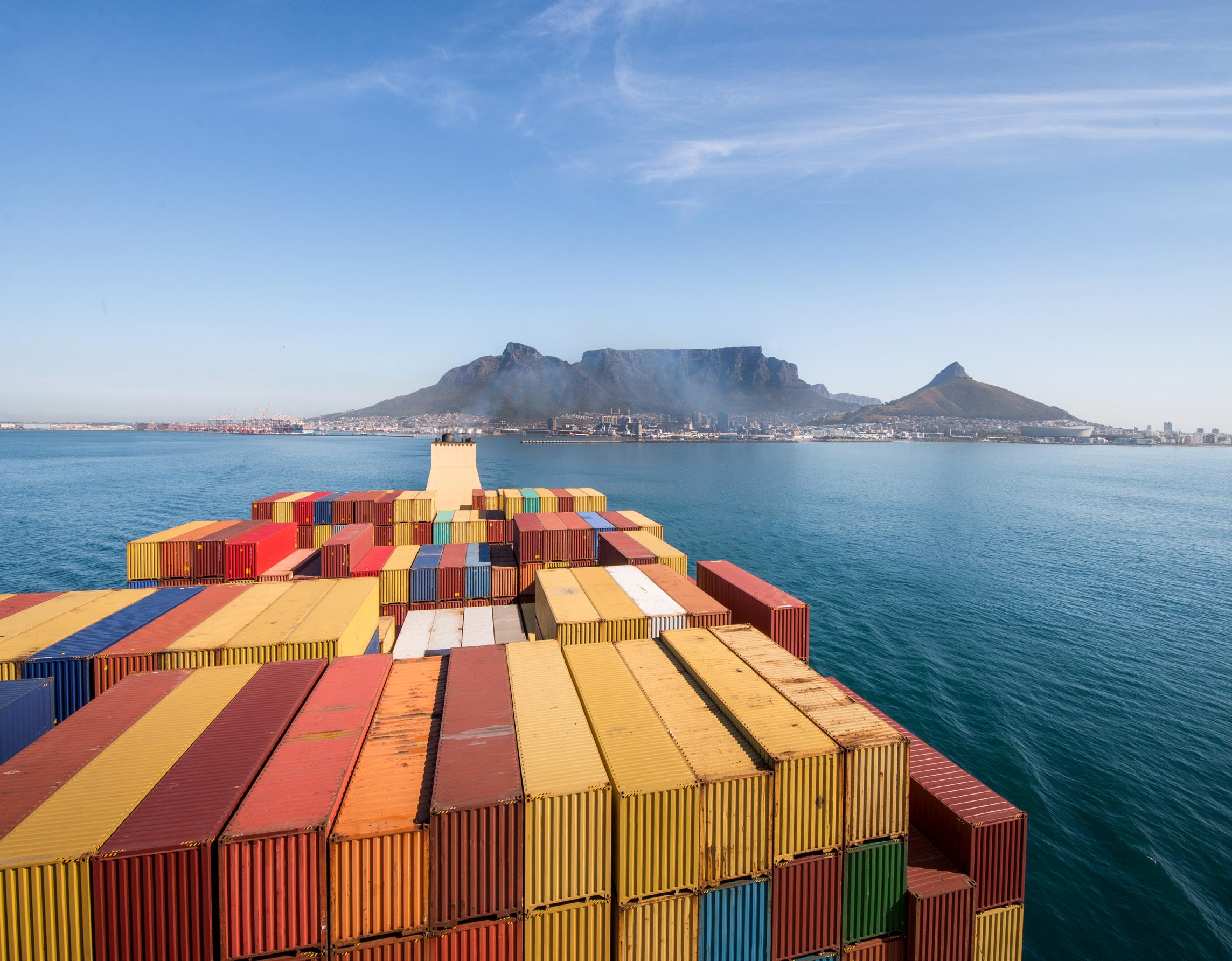


76 AFRICAN BUSINESS QUARTERLY ISSUE 15
TRANSPORT INFRASTRUCTURE TRANSPORT INFRASTRUCTURE


COMPANY ACHIEVMENTS

The laboratory started operating in February 2015 but towards the end of July 2015, the laboratory underwent a SANAS assessment for initial accreditation. On the 30 th November 2015, the laboratory obtained its ISO 17025/2005 Accreditation. This accreditation was achieved within a period of nine (9) months.On the 30 th November 2020, the laboratory became one of the few to be accredited on the revised ISO 17025/2017.
LABORATORY QUALITY MANAGEMENT SYSTEM
The facility measures in place to ensure quality results. Some of the measures taken for validity of results are making use of certifies reference material for intermediate checks, making use of control charts and participating in proficiency test. The method used to perform the analysis are validated and deemed acceptable for thye intended use. In addition there are customer, tinternal and external audits conducted to ensure continous improvement in our systems


BACKGROUND
Vitrovian Analytical Services, trading as VAS, is a coal laboratory that is situated inside Delmas town (Mpumalanga) i.e. about 19km N.E. of Springs, 73 km S.E. of Pretoria and about 100Km West of Witbank.
It is one of the South African 100% black owned coal laboratories that render analytical services to the coalmines in Mpumalanga Province.
The Laboratory was established late in year 2014 and started to operate in to early 2015 as an additional division to the existing variety of operations under Vitrovian Trading Projects (Pty) whose main office is in Witbank Mpumalanga.
LABORATORY ACCREDITATION AND CERTFICATION
VAS is accredited for 11 methods and has 4 SANAS approved technical signatories that works full time in monitoring and approval of coal analysis conducted in the laboratory. Accredited methods are as follows :
• Determination of Ash content in coal - ISO 1171
• Determination of Volatile matter in coal - ISO 562
• Determination of Moisture content in coal – SANS 5925
• Determination of Calorific value in coal – ISO 1928
• Determination of Total Sulphur in coal – ASTM D4239
• Determination of Sample Preparation – ISO 13909
• Determination of Total moisture – ISO 589
• Determination of Float and Sink – ASTM D4371
• Determination of Abrasive Index – Eskom method
• Determination of Sizing – ISO 1953
• Determination of Ash Fusion Temperature, Reducing only –ISO 540

A NEW ERA OF TRAVEL
Shifting megatrends see the rapid evolution of electric air taxis and emergence of generative AI as driving forces in travel and transport
78 AFRICAN BUSINESS QUARTERLY ISSUE 15
TRANSPORT AIR TRAVEL
TRANSPORT AIR TRAVEL

With the arrival of generative artificial intelligence in 2023, the technology has surged to the top of airport and airline agendas, with 97% of airlines planning a programme to develop the tech. This has taken the limelight away from the Metaverse, which was the focus for 2022.
Similarly, urban air mobility (UAM) has seen surging interest from airlines and airports, with the first flights due to take off in 2024. As a result, investment in the space across all stakeholders (including original equipment manufacturing, infrastructure and systems) is projected to accelerate from $5 billion in 2022 to $28 billion in 2030 (shorturl.at/byMO3).
These were some key findings of SITA’s (www.sita.aero) updated “Meet the Megatrends” report (shorturl.at/gruzC), highlighting the
industry’s rapidly changing innovation landscape. The report examines 12 emerging technological, societal, traveller and economic trends that will significantly morph the travel landscape by 2033.
While some megatrends identified in 2022 have witnessed rapid growth in the last 12 months, others also continued to develop, including digital travel, with the emergence of digital identities.
According to SITA’s 2023 Air Transport IT Insights, by the end of 2026, 82% of airlines will use biometric-enabled digital identity technologies for aircraft boarding, while a further 67% confirmed using touchless and 50% single token.
2023’s meteoric rise of generative AI
New data from SITA’s 2023 IT Insights shows
that 86% of airlines are collaborating with innovation partners to make advancements in AI, machine learning (ML) and computer vision. Thirty-nine percent of these have already been implemented, while another 47% confirmed plans by the end of 2026. Only 3% of airlines stated having no plans to invest in AI technologies.
In comparison, 97% confirmed major programmes and research & development (R&D). Looking at airports, 16% of airports already use AI and ML for improved decisionmaking, with another 51% confirming plans to implement such solutions by the end of 2026.
UAM’s rapid evolution Increased demand for short-range routes, advances in batteries and electric propulsion systems, and the increasing efforts to reduce aviation’s carbon footprint and operational costs have all contributed to the UAM transportation sector’s impressive growth in 2023. Taking to the air rather than the road may soon be possible in Paris: an electric air taxi service is in the pipeline and could be launched during the 2024 Olympic Games.
Airlines show increased interest in UAM, with 32% confirming major programmes and R&D in UAM services and infrastructure. Thirty-three percent of airlines invest in vertical takeoff and landing (VTOL) integration technologies for airline operations.
UAM services and infrastructure are taking off for airports, with 32% confirming major programmes and R&D on this front. Furthermore, 57% of airports confirmed major programmes and R&D plans for integrating intermodal transport systems for data sharing, with 26% investing in technologies for VTOL integration.
Patrik Svensson Gillstedt, senior vice-president of Strategy and Growth Enablement at SITA, says: “It’s an exciting time for travel, with new technologies transforming our industry at rates previously unseen. While AI is a key example of this, it’s encouraging to see other innovations like UAM, digital travel and intermodal travel also gathering pace.
“At SITA, we have cultivated a more open approach to innovation jointly with our customers and industry groups to try many things to relieve difficult problems in agile-lean
ISSUE 15 AFRICAN BUSINESS QUARTERLY 79
“It’s an exciting time for travel, with new technologies transforming our industry at rates previously unseen.”
ways. Partnering with experts where we see a big opportunity, canvassing the imagination and talent of our employees across the entire organisation, and drilling down into hyperefficient models for validating ideas and nurturing them through the development cycle has been a focus for us.”
The report was spearheaded by the SITA Lab innovation team and draws upon insights from across the transport industry, SITA’s global research and the latest cutting-edge proof of concepts to identify the most powerful shifts that will drive the travel industry’s evolution by 2033.

SUMMARY OF THE NEW MEGA TRENDS
1. THE SHIFTING STAFF CULTURE AND GREAT RESIGNATION
Airports and airlines will have to restructure their workforces using technology to work differently. Technology means achieving more scalable operations and upskilling employees to support these changes, with a more significant focus on service.
2.THE MILLENNIAL AND GEN Z TRAVELLERS
Younger travellers demand a more integrated digital journey, and the industry will be forced to respond. They will accelerate the digital way of life and popularise fringe technologies by 2027. Many are frequent travellers who are ‘self-service first’, and they embrace biometrics and digital passes to benefit from travel efficiency and convenience.
3. PRIVACY, DIGITAL IDENTITY RIGHTS AND CONTROLS FOR PASSENGERS
We are moving toward a future where passengers can travel from anywhere to everywhere without ever needing to present travel documents and without needing to stop to confirm their identity, check in, cross a border or access any number of services at their destination—all while keeping control of where and when data is shared.
4. THE AGEING TRAVELLER
We will travel longer into our old age and have more disposable income. This will deepen the demographic of ageing travellers who require more assistance throughout the journey. Bespoke technological solutions and bolstered staff resources at airports will be dedicated to supporting the ageing traveller by 2030. A subsection of technology innovation will emerge designed to address the needs of the senior traveller specifically.
5. FULL DIGITAL ECONOMY
Airports are looking to fill pandemic-inflicted revenue holes: Enabling mobile payments, improving personalisation and increasing ancillary services are focus areas for most airports. Mobile commerce (m-commerce) and buy-now-pay-later services will drive e-commerce growth and transform purchasing experiences throughout the passenger journey.
6. FLATTENED BUSINESS ORGANISATIONS
The automation and emergence of smart airports will give rise to a new flattened business organisation, eliminating the more mundane and laborious work through technology.
TRANSPORT AIR TRAVEL 80 AFRICAN BUSINESS QUARTERLY ISSUE 15
IQTech Fuel Management
With IQTech FLEET MONITORING, you can monitor vehicles, drivers and all other aspects of your fleet. Designed to service large fleets, small fleets and everything in between. Further more, FUEL MANAGEMENT forms an integral part in FLEET MANAGEMENT which keeps you in the loop of how fuel is used, which quantities are spent and finally how much is added. IQTech allows you to always know the status of your fleet.
Fuel Management
Managing fuel is like managing money. Like any other company expense, it needs to be constantly monitored and managed to ensure that no fuel is stolen, that the company can assess the value of the trip taken, and lastly create comprehensive reports on company expenses.
What is Fuel Monitoring?
With technology and management systems improving, so does the need for constant administrative control, especially when dealing with large fleets. All systems can accommodate up to 2 fuel tanks simultaneously.
How does it work?
A Fuel Tank Level Sensor (TLS) fitted to the tank and an IQTech device fitted to the vehicle/bowser. TLS connects to the IQTech system which in turn provides the user with fuel information provided by the system.
Cloud Server Saved to the cloud
All data is updated every few minutes to the server and made instantly available on our online portal. Receive alarm notifications directly to your phone and have all your site history instantly accessible
Remote Access Reports and control
Access your sites from anywhere in the world. View the latest fuel events or pull up reports from months back. See current fuel levels and a live summary health report on all your sites from the comfort of your home, office or holiday destination.

IQTech Controller
Main fuel controller
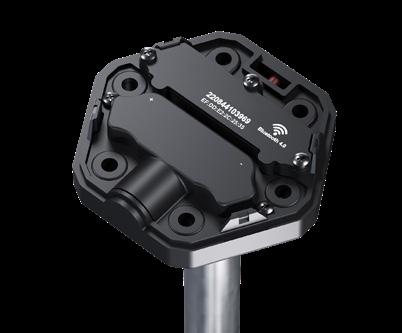
Live Levels
Tank level sensor
The IQTech Controller with remote adjustable LCD display including covert non-display settings. The adjustable brightness allows easy viewing from any angle.
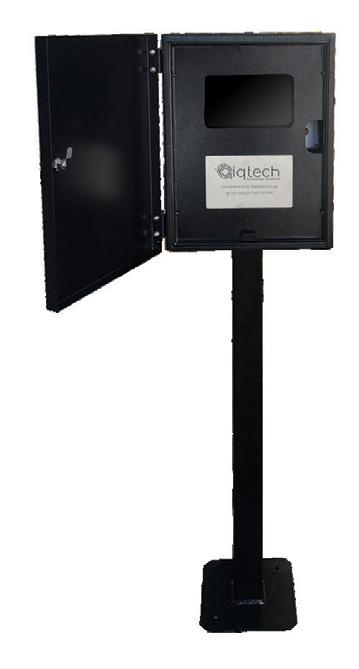

Reading Flow Flow meter
The accurate volumes dispensed can be metered by an array of different digital flow meters


• Input Voltage: 220VAC / 12VDC / 24VDC
• Fuel Flow Capacity: 5l/min – 120l/min
• Operating Pressure: 10Bar Max
• Piping: 1” BSP Fittings
• Display: 8” Color LCD Touchscreen
• Communication: 4G LTE / WiFi
Pump Control Solenoid switch
Control the flow of fuel from the pump with an electrically controlled valve to prevent dispensing from unauthorised ID Tags
Our tank level sensor displays live fuel levels at the controller and web portal as well as monitoring any fuel adds and drops with precision, providing fuel theft alerts and low level alarms.
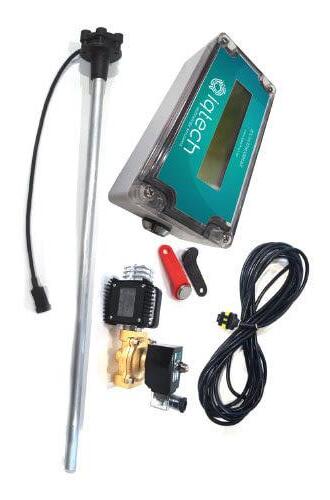
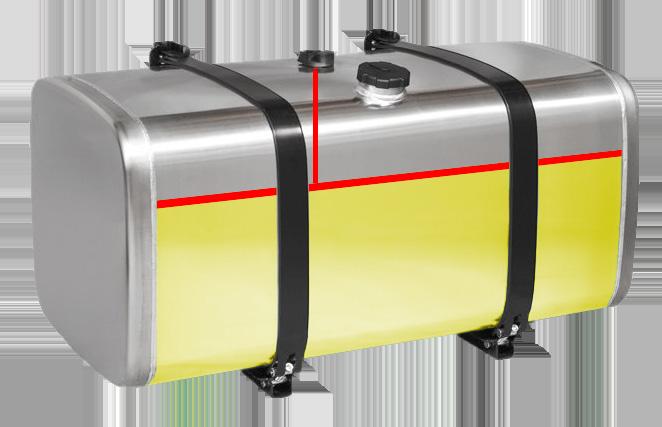
iqtech.co.za | +27 (0)87 059 0275 | info@iqtech.co.za | sales@iqtech.co.za it’s|in|the|detail
7. AIRPORT OPERATIONS GENERATIVE AI
The last year has seen significant announcements and global public attention toward emerging AI and large language model platforms like ChatGPT. Capturing both the public’s imagination and sparking fears around the rapid evolution of these transformative technologies, many industries are now speculating over the future of their products and services in a shifting technological landscape.
8. MULTIMODAL TRAVEL
Over the next seven years, seamless intermodal travel will emerge with single processing and verification points that enable a fluid end-to-end journey across land, sea and air.
9. AUTONOMOUS, ELECTRIC VEHICLE GROWTH SUPPORTED BY AI AND 5G
In the airport, the arrival of 5G and the maturation of AI solutions will see connected autonomous robots, vehicles and mobility equipment to support passengers and staff. The result will be more autonomous tracking and controlling of autonomous activities, and vehicles that assist passenger journeys at major international airports.
10. SUSTAINABILITY
By 2030, sustainability and adapting to the impacts of a warming climate will be at the heart of travel. The implementation of policies such as the Corporate Sustainability Reporting Directive in the European Union and evolving Securities and Exchange Commission policies in the United States will intensify scrutiny of the environmental and social actions and commitments of the entire aviation industry supply chain.
11. SUPPLY CHAIN TRANSFORMATION
The travel industry will experience a sharp shift from simple forecasts and demand plans to an agile supply chain based on real-time data. Digital chain of custody and non-fungible tokens (NFTs) will supersede traditional processes, where instant and verifiable data can be accessed digitally.
12. URBAN AIR MOBILITY
By 2032, electric air taxis will be ubiquitous at major international airports and operate as an effective auxiliary service and revenue stream for airports and airlines. The services will push travel closer to a seamless journey with short transfers and speedy passenger processing on top of added sustainability and energy cost benefits.
The report examines 12 emerging technological, societal, traveller and economic trends that will significantly morph the travel landscape by 2033.

TRANSPORT AIR TRAVEL
TRANSPORT AIR TRAVEL
82 AFRICAN BUSINESS QUARTERLY ISSUE 15

Integrated, sustainable solution architects
www.ukwazi.com
The School of Concrete Technology

Professional, focused courses to accelerate your career in concrete technology
Contact the SCT to discuss the best concrete technology educational path for you
+27 (0)11 315 0300 | sct@cemcon-sa.org.za | www.cemcon-sa.org.za


















































































































































































